Chapter 7 Fraction and Its Representation
Fraction
A fraction is a number representing part of a whole. The whole may be a single object or a group of objects. It is defined as
\(\text { Fraction }=\frac{\text { Numerator }}{\text { Denominator }}=\frac{a}{b}\)Here, the denominator can never be zero.
e.g. (1) \(\frac{1}{5}\) is a fraction and it is read as one-fifth, which means that 1 part out of 5 equal parts in which the whole is divided. Also, here 1 is called, the numerator and 5 is called, the denominator.
(2) If we take a pizza and divide it equally among 4 persons, then each person will have \(\frac{1}{4}\) or written in word, one quarter of the pizza.
Read and Learn More MP Board Class 6 Maths Solutions
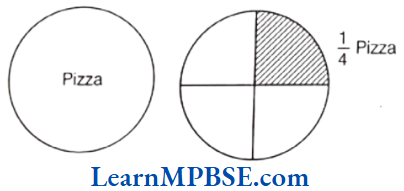
Example 1. What fraction of a day is 15 h?
Solution. We know that, one day = 24 h
∴ The required fraction = \(\frac{15 \mathrm{~h}}{24 \mathrm{~h}}=\frac{15}{24}\)
Mp Board Class 6 Book Solutions
Example 2. Write the fraction representing the shaded portion.
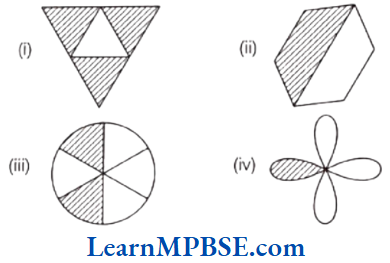
Solution. (1) Total number of equal parts = 4 and shaded parts = 3
∴ Fraction representing the shaded portion
\(=\frac{\text { Number of shaded parts }}{\text { Total number of equal parts }}=\frac{3}{4}\)(2) Total number of equal parts = 2 and shaded part = 1
∴ Fraction representing the shaded portion
\(=\frac{\text { Number of shaded parts }}{\text { Total number of equal parts }}=\frac{1}{2}\)(3) Total number of equal parts = 6 and shaded parts = 2
∴ Fraction representing the shaded portion
\(=\frac{\text { Number of shaded parts }}{\text { Total number of equal parts }}=\frac{2}{6}\)(4) Total number of equal parts = 4 and shaded part = 1
∴ Fraction representing the shaded portion
\(=\frac{\text { Number of shaded parts }}{\text { Total number of equal parts }}=\frac{1}{4}\)Example 3. Shade the part according to the given fraction.
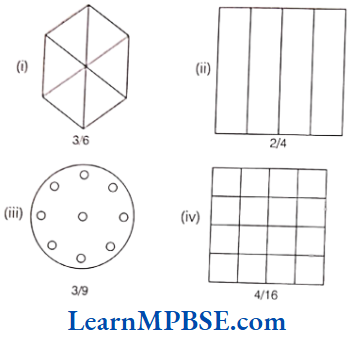
Solution. The figures are shaded as per given fraction shown below
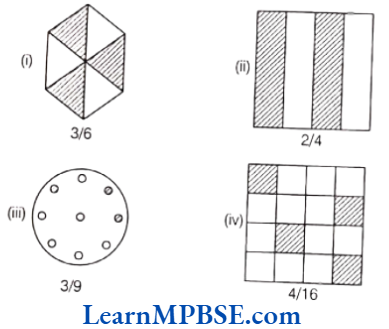
Example 4. Identify the error, if any.
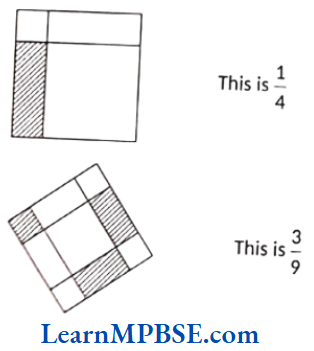
Solution. (1) In this given figure, four parts are not equal.
So, fraction is not equal to \(\frac{1}{4}\)
(2) In this given figure, all the nine parts are not equal.
Fraction is not equal to \(\frac{3}{9}\).
Example 5. What fraction of these boxes have a cross (x) In them?

Solution. Total number of boxes = 8,
Number of boxes having cross sign (x) = 3
∴ Required fraction
\(=\frac{\text { Number of boxes having cross sign ( } \mathbf{x})}{\text { Total number of boxes }}=\frac{3}{8}\)Mp Board Class 6 Book Solutions
Example 6. Write the natural numbers from 113 to 125. What fraction of them are prime numbers?
Solution. Natural numbers from 113 to 125
= 113, 114, 115, 116, 117, 118, 119, 120, 121, 122, 123, 124, 125.
Total natural numbers = 13
Prime number from 113 to 125 = 113
Total prime numbers = 1
∴ Required fraction \(=\frac{\text { Total prime numbers }}{\text { Total natural numbers }}=\frac{1}{13}\)
Example 7. Three girls Manisha, Sakshi and Shubhangini shared lunch at school. Manisha has brought two burgers, one is veg burger and one is non-veg. The other two girls forget to bring their lunch.
Manisha agreed to share her burgers so that each person will have an equal share of each burgers.
(1) How can Manisha divided her burgers so that each person has an equal share?
(2) What part of a burger will every girl receive?
Solution. Total number of burgers = 2,
Total number of girls = 3
(1) Here, Manisha has to divide 2 burgers into three person. So, she will divided each burger into three equal parts and give one part of each burger to each of them.
Thus, each person will get \(\frac{2}{3}\) burgers.
(2) One burger is to be divided among three girls.
Total number of parts = 6
Each gets 2 parts out of 6.
Then, the fraction = \(\frac{2}{6}\)
∴ Each girl will get = part of a burger.
Chapter 7 Fractions Representation on Number Line and Types of Fraction
Fraction on the Number Line
Every fraction has a point associated with it on the number line. For this, we will need to divide the gap of 0 to 1 into as many equal parts as in the denominator of that fraction.
Suppose, we want to denote the fraction \(\frac{5}{7}\) on the number line. Now, take a line OP of unit length.

Divide line OP into seven equal parts and take 5 parts out of it to reach the point A. Then, the point A represents the number \(\frac{5}{7}\).
Mp Board Class 6 Book Solutions
Example 1. Show \(\frac{4}{5}\) on a number line.
Solution. We know that \(\frac{4}{5}\) is greater than zero but less than 1. So, it will lie between 0 and 1.
Now, we have to show \(\frac{4}{5}\) on a number line.
So, we have to divide the length between 0 and 1 into 5 equal parts and take 4 parts out of it to reach point A.
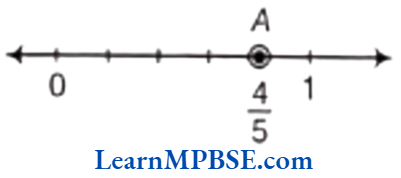
Then, the point A represents the number
Example 2. Write the fraction denoted by point A

Solution. Point A is marked at fifth place out of 10.
Therefore, fraction is \(\frac{5}{10}\).
Mp Board Class 6 Book Solutions
Example 3. Show \(\frac{2}{9}, \frac{5}{9}, \frac{0}{9} \text { and } \frac{9}{9}\) on a number line.
Solution. We know that, all given fractions are greater than or equal to zero but less than or equal to 1.
So, we have to divide the gap between 0 and 1 into nine equal parts, then each part shows \(\frac{1}{9}\) and 2 part shows \(\frac{2}{9}\), 5 part shows \(\frac{5}{9}\), 9 part shows \(\frac{9}{9}\)
Also, 0 shows \(\frac{0}{9}\).
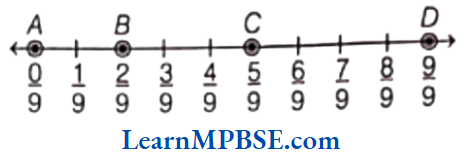
Hence, points A, B, C and D respectively represents the fraction \(\frac{0}{9}, \frac{2}{9}, \frac{5}{9} \text { and } \frac{9}{9} \text {. }\)
Example 4. Write five fraction between 0 and 1 that you can show and depict them on the number line.
Solution. As, we know that, we can show many fractions which are greater than 0 and less than 1
i.e. between 0 and 1.
Five fractions are \(\frac{1}{6}, \frac{2}{6}, \frac{3}{6}, \frac{4}{6} \text { and } \frac{5}{6}\)
These fraction are shown on a number line as given below.

Hence, points A, B, C, D and E represent \(\frac{1}{6}, \frac{2}{6}, \frac{3}{6}, \frac{4}{6}\) and \(\frac{5}{6}\) respectively.
Note It Between two whole numbers, there lie infinite fractions.
Types of Fraction
Proper Fraction
A fraction whose numerator is always less than the denominator is called a proper fraction.
i.e. Numerator < Denominator.
e.g. \(\frac{9}{10}\), \(\frac{5}{8}\) are proper fractions. It is always less than 1. So, if 10’8 we represent a proper fraction on a number line, it will always lie to the left of 1.
Mp Board Class 6 Maths Solutions
Example 5. Choose the proper fraction from the following numbers.
\(6 \frac{1}{2}, \frac{8}{3}, \frac{2}{9}, 7 \frac{2}{3}\)
Solution. A fraction is proper fraction, if numerator is less than denominator.
Therefore, \(\frac{2}{9}\) is a proper fraction.
Example 6. Give a proper fraction:
(1) Whose numerator is 4 and denominator is 7.
(2) Whose denominator is 8 and numerator is 1.
(3) Whose numerator and denominator add upto 8. How many fractions of this kind can you make?
(4) Whose denominator is 3 more than numerator. (Give any five. How many more can you make?)
Solution. (1) Numerator = 4 and denominator = 7
∴ Required fraction = \(\frac{4}{7}\)
(2) Numerator = 1 and denominator = 8
∴ Required fraction = \(\frac{1}{8}\)
(3) Possible pairs of numerator and denominator which
add upto 8 are (0, 8), (1, 7), (2, 6), (3, 5).
Now, proper fractions = \(\frac{0}{8}, \frac{1}{7}, \frac{2}{6}, \frac{3}{5}\)
There are four fraction.
So, we can make four such fractions.
(4) There can be infinite number of fractions whose denominator is 3 more than the numerator.
Some of them \(\frac{0}{3}, \frac{1}{4}, \frac{2}{5}, \frac{3}{6}, \frac{4}{7} \ldots \ldots\) so on.
Improper Fraction
A fraction whose numerator is always greater than the denominator is called an improper fraction.
i.e. Numerator > denominator.
e.g. \(\frac{3}{2}\), \(\frac{18}{5}\) are improper fractions.
It is always greater than 1. So, if we represent an improper fraction on a number line, it will always lie to the right of 1.
Mp Board Class 6 Maths Solutions
Example 7. Write five improper fractions with denominator 8.
Solution. Five improper fractions with denominator 8 are \(\frac{9}{8}, \frac{10}{8}, \frac{11}{8}, \frac{12}{8}, \frac{13}{8}\)
Mixed Fraction
A fraction which is a combination of a whole number and a proper fraction (or part) is called a mixed fraction.
e.g. \(1 \frac{1}{4}\) is a mixed fraction. Here, I is a whole number and \(\frac{1}{4}\) is a proper fraction.
Example 8. Combine the following as a mixed fraction.
(1) 2 and one-third
(2) 5 and \(\frac{3}{5}\)
Solution. (1) We have, 2 and one-third.
Here, whole part = 2
and proper fraction part = One-third = \(\frac{1}{3}\)
∴ Mixed fraction = \(2 \frac{1}{3}\)
(2) We have, 5 and \(\frac{3}{5}\)
Here, whole part = 5 and proper fraction = \(\frac{3}{5}\)
∴ Mixed fraction = \(5 \frac{3}{5}\)
Conversion of an Improper Fraction into a Mixed Fraction
To express an improper fraction as a mixed fraction, firstly we divide the numerator by denominator to obtain the quotient and the remainder. Then,
Mixed fraction = \(\text { Quotient } \frac{\text { Remainder }}{\text { Divisor }}\)
e.g. Consider an improper fraction = \(\frac{17}{4}\)
Now, dividing numerator by denominator
i.e. 17 by 4, we get quotient = 4 and remainder = 1
Hence, mixed fraction = \(4 \frac{1}{4}\)
MP Board Class 6 Maths Solutions
Example 9. Express the following as mixed fractions.
(1) \(\frac{19}{3}\)
(2) \(\frac{14}{4}\)
(3) \(\frac{17}{7}\)
(4) \(\frac{33}{9}\)
Solution. (1) We have, \(\frac{19}{3}\)
On dividing 19 by 3, we get quotient = 6 and remainder = 1.
Hence, mixed fraction = \(6 \frac{1}{3}\)
(2) We have, \(\frac{14}{4}\)
On dividing 14 by 4, we get quotient = 3 and remainder = 2
Hence, mixed fraction = \(3 \frac{2}{4}\)
(3) We have, \(\frac{17}{7}\)
On dividing 17 by 7, we get quotient = 2 and remainder = 3
Hence, mixed fraction = \(2 \frac{3}{7}\)
(4) We have \(\frac{33}{9}\)
On dividing 33 by 9, we get quotient = 3 and remainder = 6
Hence, mixed fraction = \(3 \frac{6}{9}\)
Conversion of a Mixed Fraction into an Improper Fraction
Multiply the whole number with denominator of the fraction and then add the numerator of the fraction. This gives the numerator of the required improper fraction. Its denominator is the same as the denominator of the fractional part of mixed fraction.
Improper fraction \(=\frac{\text { Whole part } \times \text { Denominator }+ \text { Numerator }}{\text { Denominator }}\)
MP Board Class 6 Maths Solutions
Example 10. Express the following fractions as improper fractions.
(1) \(3 \frac{2}{5}\)
(2) \(2 \frac{3}{7}\)
(3) \(7 \frac{1}{4}\)
(4) \(3 \frac{1}{6}\)
(5) \(7 \frac{3}{8}\)
(6) \(11 \frac{3}{2}\)
Solution.
(1) We have, \(3 \frac{2}{5}=3+\frac{2}{5}=\frac{3 \times 5+2}{5}=\frac{17}{5}\)
(2) We have, \(2 \frac{3}{7}=2+\frac{3}{7}=\frac{2 \times 7+3}{7}=\frac{17}{7}\)
(3) We have, \(7 \frac{1}{4}=7+\frac{1}{4}=\frac{7 \times 4+1}{4}=\frac{29}{4}\)
(4) We have, \(3 \frac{1}{6}=3+\frac{1}{6}=\frac{3 \times 6+1}{6}=\frac{19}{6}\)
(5) We have, \(7 \frac{3}{8}=7+\frac{3}{8}=\frac{7 \times 8+3}{8}=\frac{59}{8}\)
(6) We have, \(11 \frac{3}{2}=11+\frac{3}{2}=\frac{22+3}{2}=\frac{25}{2}\)
Chapter 7 Fractions Equivalent Fraction and Simplest Form of a Fraction
Equivalent Fraction
Fractions having the same values are called equivalent fractions. To find an equivalent fraction of a given number, we multiply or divide the numerator and the denominator of the given fraction by the same non-zero number.
Example 1. Find five equivalent fractions of each of the following
(1) \(\frac{2}{3}\)
(2) \(\frac{1}{5}\)
Solution.
(1) Given, fraction is \(\frac{2}{3}\).
∴ \(\frac{2}{3}=\frac{2 \times 2}{3 \times 2}=\frac{2 \times 3}{3 \times 3}=\frac{2 \times 4}{3 \times 4}=\frac{2 \times 5}{3 \times 5}=\frac{2 \times 6}{3 \times 6}\)
⇒ \(\frac{4}{6}=\frac{6}{9}=\frac{8}{12}=\frac{10}{15}=\frac{12}{18}\)
Hence, the five fractions equivalent to \(\frac{2}{3}\) are \(\frac{4}{6}, \frac{6}{9}, \frac{8}{12}, \frac{10}{15} \text { and } \frac{12}{18}\).
(2) Given, fraction is \(\frac{1}{5}\).
\(\frac{1}{5}=\frac{1 \times 2}{5 \times 2}=\frac{1 \times 3}{5 \times 3}=\frac{1 \times 4}{5 \times 4}=\frac{1 \times 5}{5 \times 5}=\frac{1 \times 6}{5 \times 6}\)⇒ \(\frac{2}{10}=\frac{3}{15}=\frac{4}{20}=\frac{5}{25}=\frac{6}{30}\)
Hence, the five fractions equivalent to \(\frac{1}{5}\) are \(\frac{2}{10}, \frac{3}{15}, \frac{4}{20}, \frac{5}{25} \text { and } \frac{6}{30} .\)
Example 2. Give example of four equivalent fractions.
Solution. Four equivalent fractions are \(\frac{1}{3}, \frac{2}{6}, \frac{3}{9}, \frac{4}{12},\) etc.
To Test Whether Two Given Fractions are Equivalent or not
We can check whether two fractions are equivalent or not by finding their cross product i.e. we multiply the numerator of first fraction with the denominator of second fraction and the denominator of first fraction with the numerator of sechond fraction. If the two products are equal, then the given fractions are equivalent, otherwise not.
Let \(\frac{a}{b}\) and \(\frac{c}{d}\) be two given fractions. Their cross multiplication shown as
(1) If ad = bc, then \(\frac{a}{b}\) and \(\frac{c}{d}\) are equivalent.
(2) If ad < bc, then \(\frac{a}{b}\) < \(\frac{c}{d}\)
(3) If ad > bc, then \(\frac{a}{b}\) > \(\frac{c}{d}\)
Class 6 Maths Chapter 7 Solutions Mp Board
Example 3. Check whether the fractions \(\frac{5}{8}\) and \(\frac{15}{24}\) are equivalent or not.
Solution. Let \(\frac{a}{b}\) = \(\frac{5}{8}\), \(\frac{c}{d}\) = \(\frac{15}{24}\).
By Cross multiplication \(\frac{a}{b} \times \frac{c}{d}\)
We have \(\frac{5}{8} \times \frac{15}{24}\),
Here, ad = bc i.e. 5 x 24 = 15 x 8 = 120
So, \(\frac{5}{8}\) and \(\frac{15}{24}\) are equivalent.
Example 4. Identify the fractions in each. Are these fractions equivalent?
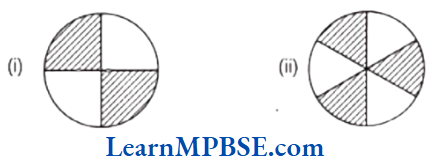
Solution. (1) Here, the total parts is 4, out of which 2 parts are shaded. So, required fraction = \(\frac{2}{4}\)
(2) Here, total parts are 6, out of which 3 parts are shaded. So, required fraction = \(\frac{3}{6}\)
Now, take \(\frac{2}{4}\) and \(\frac{3}{6}\). Here, 2 x 6 = 12 and 3 × 4 = 12
∴ 12 = 12,
∴ \(\frac{2}{4}\) and \(\frac{3}{6}\) are equivalent.
Example 5. Write a fraction equivalent to \(\frac{3}{5}\) with numerator 12.
Solution. Let D stands for denominator.
Given, numerator of an equivalent fraction = 12
\(\frac{12}{D}\) = \(\frac{3}{5}\) ⇒ D x 3 = 12 x 5 ⇒ D = \(\frac{12 \times 5}{3}=20\)
Hence, required equivalent fraction of \(\frac{3}{5}\) is \(\frac{12}{20}\).
Example 6. Write a fraction equivalent to with denominator 35.
Solution. Let N stands for numerator.
Given, denominator of an equivalent fraction = 35
\(\frac{N}{35}\) = \(\frac{5}{7}\) ⇒ N x 7 = 35 x 5 ⇒ N = \(\frac{35 \times 5}{7}\) = 25
Hence, required equivalent fraction of \(\frac{5}{7}\) is \(\frac{25}{35}\).
Simplest Form of a Fraction
A fraction is said to be in the simplest (or lowest) form if its numerator and denominator have no common factor except 1. i.e their HCF =1.
To find the equivalent fraction in the simplest form, firstly we find the HCF of the numerator and denominator and then divide both of them by their HCF.
Class 6 Maths Chapter 7 Solutions Mp Board
Example 7. Write the simplest form of
(1) \(\frac{28}{42}\)
(2) \(\frac{36}{49}\)
Solution. (1) We have, \(\frac{28}{42}\)
Now, factors of 28 = 2, 2, 7 and factors of 42 = 2, 3, 7 Common factors = 2 and 7
∴ HCF of 28 and 42 = 2 x 7 = 14
Then, \(\frac{28}{42}=\frac{28 \div 14}{42 \div 14}=\frac{2}{3}\)
Hence, fraction \(\frac{2}{3}\) is the simplest form of given fraction.
(2) Here, factors of 36 = 6, 6 and factors of 49 = 7, 7
∴ 36 and 49 have no common factor except 1.
Hence, fraction \(\frac{36}{49}\) is in simplest form.
Chapter 7 Fractions Like, Unlike and Comparing Fractions
Like and Unlike Fractions
Fractions having same denominator are called like fractions.
e.g. \(\frac{1}{7}, \frac{2}{7}, \frac{3}{7}\) etc.
While fractions having the different denominator are called unlike fractions.
e.g. \(\frac{2}{3}, \frac{1}{5}, \frac{2}{15}, \frac{7}{9}\) etc.
Conversion of Unlike Fraction into Like Fraction
Unlike fractions are converted into like fractions by converting each of them into their equivalent fractions having denominator equal to the LCM of all the denominators of all unlike fractions.
Example 1. Convert the fractions \(\frac{1}{2}\), \(\frac{2}{3}\) and \(\frac{5}{6}\) into like fractions.
Solution. The given fractions are \(\frac{1}{2}\), \(\frac{2}{3}\) and \(\frac{5}{6}\).
LCM of denominators 2, 3 and 6 = 6
We convert each of the fraction into an equivalent fraction with 6 as the denominator.
\(\frac{1}{2}=\frac{1 \times 3}{2 \times 3}=\frac{3}{6}\) \(\frac{2}{3}=\frac{2 \times 2}{3 \times 2}=\frac{4}{6}\)and \(\frac{5}{6}=\frac{5 \times 1}{6 \times 1}=\frac{5}{6}\)
The required like fractions are \(\frac{3}{6}\), \(\frac{4}{6}\) and \(\frac{5}{6}\).
Comparing Fractions
There are two methods of comparison of fractions which are given below
Comparison of Like Fractions
If two fractions have same denominator, then the fraction with the greater numerator is greater.
e.g. Between \(\frac{11}{20}\) and \(\frac{13}{20}\), the fraction \(\frac{13}{20}\) is grater.
Class 6 Maths Chapter 7 Solutions
Example 2. Which is the larger fraction?
(1) \(\frac{6}{10}\) or \(\frac{7}{10}\)
(2) \(\frac{12}{24}\) or \(\frac{13}{24}\)
Solution. We have, \(\frac{6}{10}\) or \(\frac{7}{10}\)
Here, denominators of both fractions are same and 7 > 6.
So, \(\frac{7}{10}\) > \(\frac{6}{10}\)
(2) We have, \(\frac{12}{24}\) or \(\frac{13}{24}\)
Here, denominator of both fractions are same and 13 > 12.
So, \(\frac{13}{24}\) > \(\frac{12}{24}\)
Example 3. Parul reads 20 pages of a novel containing 100 pages. Sachin reads \(\frac{2}{5}\) of the same book. Who read less?
Solution. Fraction of book read by Parul = \(\frac{20}{100}\) = \(\frac{1}{5}\)
Fraction of novel read by Sachin = \(\frac{2}{5}\)
Here, denominator of both fractions are same and 2 > 1.
∴ \(\frac{1}{5}\) < \(\frac{2}{5}\)
Hence, Parul reads less pages of the novel.
Example 4. Write the following in ascending and descending order.
(1) \(\frac{2}{9}, \frac{7}{9}, \frac{5}{9}\)
(2) \(\frac{1}{3}, \frac{11}{3}, \frac{4}{3}, \frac{7}{3}, \frac{5}{3}\)
Solution. (1) We have, \(\frac{2}{9}, \frac{7}{9}, \frac{5}{9}\)
Here, denominator of all fractions are same.
∴ Ascending order of numerator = 2 < 5 < 7
and descending order of numerator = 7 > 5 > 2
∴ Ascending order of fraction = \(\frac{2}{9}<\frac{5}{9}<\frac{7}{9}\)
and descending order of fraction = \(\frac{7}{9}>\frac{5}{9}>\frac{2}{9}\)
(2) Since, denominator of all fractions are same.
∴ Ascending order of fraction = \(\frac{1}{3}<\frac{4}{3}<\frac{5}{3}<\frac{7}{3}<\frac{11}{3}\)
and descending order of fraction = \(\frac{11}{3}>\frac{7}{3}>\frac{5}{3}>\frac{4}{3}>\frac{1}{3}\)
Class 6 Maths Chapter 7 Solutions Mp Board
Example 5. Write shaded portion as fraction. Arrange them in ascending and descending order using correct sign,>’ between the fractions.
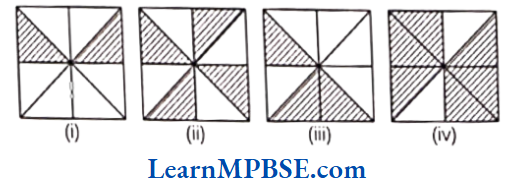
Solution. Here, total number of equal parts in all figures = 8
Shaded portion of figure (1) represents fraction = \(\frac{2}{8}\)
Shaded portion of figure (2) represents fraction = \(\frac{4}{8}\)
Shaded portion of figure (3) represents fraction = \(\frac{3}{8}\)
Shaded portion of figure (4) represents fraction = \(\frac{6}{8}\)
∴ Denominator of all fractions are same. So, we arrange them in ascending order and descending order according to their numerators.
∴ Ascending order of fractions \(\frac{2}{8}<\frac{3}{8}<\frac{4}{8}<\frac{6}{8}\)
[∴ fraction with small numerator will be smaller]
and descending order of fractions = \(\frac{6}{8}>\frac{4}{8}>\frac{3}{8}>\frac{2}{8}\)
[∴ fraction having greatest numerator will be greatest].
Comparison of Unlike Fractions
There are two types of comparison of unlike fractions.
Comparison of Unlike Fractions with Same Numerators
Among two fractions having same numerator, the one with the smaller denominator is the greater of the two.
e.g. \(\frac{7}{11}>\frac{7}{13} \text { and } \frac{11}{23}>\frac{11}{25}\)
Class 6 Maths Chapter 7 Solutions Mp Board
Example 6. Arrange the following in ascending and descending order.
\(\frac{2}{13}, \frac{2}{11}, \frac{2}{17}, \frac{2}{5}, \frac{2}{7}, \frac{2}{9}, \frac{2}{55}\)
Solution. Here, numerator of all fractions are same.
Descending order of denominators
= 55 > 17 > 13 > 11 > 9 > 7 > 5.
∴ Ascending order of fraction
= \(\frac{2}{55}<\frac{2}{17}<\frac{2}{13}<\frac{2}{11}<\frac{2}{9}<\frac{2}{7}<\frac{2}{5}\)
∴ [\(\frac{2}{55}\) has larger denominator, so it is smallest fraction].
and descending order of fractions.
= \(\frac{2}{5}>\frac{2}{7}>\frac{2}{9}>\frac{2}{11}>\frac{2}{13}>\frac{2}{17}>\frac{2}{55}\)
Example 7. Kanchan and Kiran are two friends. Kanchan get one-fifth of a bottle of apple juice and Kiran get one-fourth of a bottle of apple juice. Who gets more?
Solution. Here, we will compare one-fifth i.e. \(\frac{1}{5}\) and one-fourth i.e. \(\frac{1}{4}\).
Since \(\frac{1}{5}\) and \(\frac{1}{4}\) have same numerator, so the fraction with smaller denominator is greater.
Thus, \(\frac{1}{4}\) > \(\frac{1}{5}\)
Thus, Kiran gets more apple juice.
Comparison of Unlike Fractions with Different Numerators
If numerator and denominator both are different of given two fractions, then for comparing, we use the method of equivalent fractions i.e. we change the denominator of a fraction without changing its value.
Mp Board Maths Chapter 7 Solutions
Example 8. Compare \(\frac{5}{6}\) and \(\frac{13}{15}\).
Solution. The given fractions are unlike, we should first get their equivalent fractions with a denominator, which is common multiple of 6 and 15 i.e 30.
Now, \(\frac{5 \times 5}{6 \times 5}=\frac{25}{30} \text { and } \frac{13 \times 2}{15 \times 2}=\frac{26}{30}\)
Since, \(\frac{26}{30}>\frac{25}{30}, \text { so } \frac{13}{15}>\frac{5}{6}\)
Example 9. Arrange the following in ascending and descending order.
\(\frac{2}{3}, \frac{1}{9}, \frac{5}{12} \text { and } \frac{7}{36}\)
Solution. We have, \(\frac{2}{3}, \frac{1}{9}, \frac{5}{12}, \frac{7}{36}\)
LCM of 3, 9, 12 and 36 = 3 x 3 x 4 = 36
So, we convert each of the given fraction into an equivalent fraction with denominator 36.
Clearly, \(\frac{24}{36}>\frac{15}{36}>\frac{7}{36}>\frac{4}{36}\)
Hence, \(\frac{2}{3}>\frac{5}{12}>\frac{7}{36}>\frac{1}{9}\)
∴ Ascending order is \(\frac{1}{9}<\frac{7}{36}<\frac{5}{12}<\frac{2}{3}\) and descending order is \(\frac{2}{3}>\frac{5}{12}>\frac{7}{36}>\frac{1}{9}\)
Example 10. Find answer to the following. Write and indicate how you solved them.
(1) is \(\frac{5}{4}\) equal to \(\frac{9}{5}\) ?
(2) is \(\frac{20}{16}\) equal to \(\frac{5}{4}\) ?
Solution. (1) LCM of 4 and 5 = 20
Now, \(\frac{5}{4}=\frac{5 \times 5}{4 \times 5}=\frac{25}{20}\)
and \(\frac{9}{5}=\frac{9 \times 4}{5 \times 4}=\frac{36}{20}\)
Thus, both fractions are like fractions but \(\frac{25}{20} \neq \frac{36}{20}\)
∴ \(\frac{5}{4}\) ≠ \(\frac{9}{5}\)
(2) LCM of 16 and 4 = 16
Now, \(\frac{20}{16}=\frac{20 \times 1}{16 \times 1}=\frac{20}{16}\)
and \(\frac{5}{4}=\frac{5 \times 4}{4 \times 4}=\frac{20}{16}\)
Thus, both fraction are like fractions and \(\frac{20}{16}\) = \(\frac{20}{16}\)
∴ \(\frac{20}{16}\) = \(\frac{5}{4}\)
Mp Board Maths Chapter 7 Solutions
Example 11. Ravish takes \(2 \frac{1}{5}\) min to walk across the school ground. Rahul takes \(1 \frac{3}{4}\) min to do the same. Who takes less time and by what fraction?
Solution. Time taken by Ravish to walk across the school ground = \(2 \frac{1}{5}\) min = \(\frac{11}{5}\) min
Time taken by Rahul to walk across the school ground = \(1 \frac{3}{4}\) min = \(\frac{7}{4}\) min
The LCM of 5 and 4 = 20
∴ \(\frac{11}{5}=\frac{11 \times 4}{5 \times 4}=\frac{44}{20} \text { and } \frac{7}{4}=\frac{7 \times 5}{4 \times 5}=\frac{35}{20}\)
Now, \(\frac{35}{20}\) < \(\frac{44}{20}\)
∴ \(\frac{7}{4}\) < \(\frac{11}{5}\)
⇒ Rahul takes less time.
The difference between the time taken by Ravish and Rahul to walk across the school ground = \(\frac{11}{5}\) – \(\frac{7}{4}\)
= \(\frac{44-35}{20}=\frac{9}{20} \min\)
Thus, Rahul takes \(\frac{9}{20}\) min less than Ravish.
Example 12. Asha and Deepa have bookshelves of the same size partly filled with books. Asha’s shelf is \(\frac{5}{7}\) th full and Deepa’s shelf is \(\frac{3}{5}\) th full. Whose bookshelf is more full? By what fraction?
Solution. Here, we have to compare two unlike fractions.
Asha’s shelf = \(\frac{5}{7}\)th
Deepa’s shelf = \(\frac{3}{5}\)th
∴ LCM of 7 and 5 = 35
∴ \(\frac{5}{7}=\frac{5 \times 5}{7 \times 5}=\frac{25}{35} \text { and } \frac{3}{5}=\frac{3 \times 7}{5 \times 7}=\frac{21}{35}\)
∴ 25 > 21
∴ \(\frac{5}{7}\) > \(\frac{3}{5}\)
Hene, Asha’s bookshelf is filled more than Deepa’s bookshelf.
∴ Difference = \(\frac{5}{7}-\frac{3}{5}=\frac{25}{35}-\frac{21}{35}=\frac{4}{35}\)
Therefore, Asha’s bookshelf is more full by \(\frac{4}{35}\) th than Deepa’s bookshelf.
Chapter 7 Fractions Addition and Subtraction of Like Fractions
Addition of Like Fractions
To add like fractions, we add their numerators keeping denominator unchanged and then write it in simplest form.
Suppose, we have two like fractions \(\frac{a}{b}\) and \(\frac{c}{b}\) , then sum = \(\frac{a+c}{b}\)
∴ Sum of like fractions \(=\frac{\text { Sum of their numerators }}{\text { Common denominator }}\)
e.g. By pictorial representation
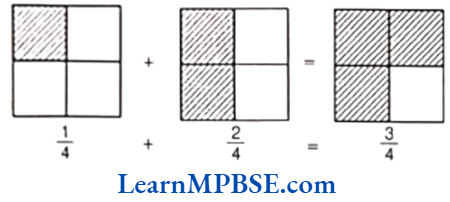
Mp Board Maths Chapter 7 Solutions
Example 1. Add
(1) \(\frac{1}{8}+\frac{1}{8}\)
(2) \(\frac{2}{5}+\frac{3}{5}\)
Solution. (1) Let \(\frac{a}{b}\) = \(\frac{1}{8}\) and \(\frac{c}{b}\) = \(\frac{1}{8}\), then sum = \(\frac{a+c}{b}=\frac{1+1}{8}=\frac{2}{8}=\frac{1}{4}\)
Hence, the sum of \(\frac{1}{8}\) and \(\frac{1}{8}\) is \(\frac{1}{4}\).
(2) Let \(\frac{a}{b}\) = \(\frac{2}{5}\) and \(\frac{c}{b}\) = \(\frac{3}{5}\), then sum = \(\frac{a+c}{b}=\frac{2+3}{5}=\frac{5}{5}=1\)
Hence, the sum of \(\frac{2}{5}\) and \(\frac{3}{5}\) is 1.
Example 2. Add the shaded part of the fraction for the given figure.
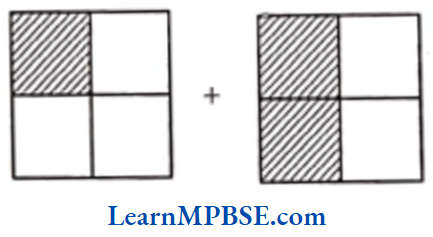
Solution. We have,
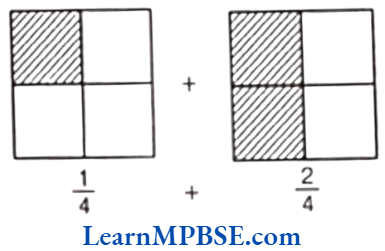
Then, pictorial representation of \(\frac{3}{4}\) is
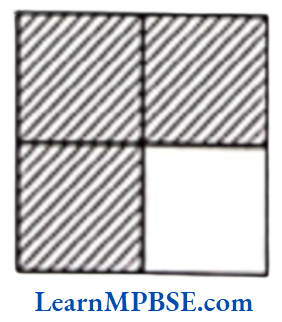
Mp Board Maths Chapter 7 Solutions
Example 3. Add these with the help of a diagram.
(1) \(\frac{2}{6}+\frac{3}{6}\)
(2) \(\frac{1}{3}+\frac{1}{3}+\frac{1}{3}\)
Solution. (1) Here, draw two rectangles and divide them into 6 equal parts separately. In first rectangle, 2 parts out of 6 parts are shaded and in second rectangle, 3 parts out of 6 parts are shaded. On adding them, we get
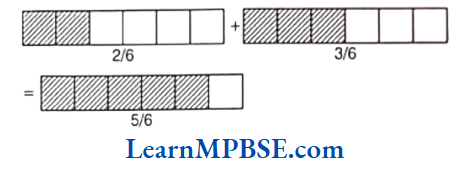
i.e. \(\frac{2}{6}+\frac{3}{6}=\frac{2+3}{6}=\frac{5}{6}\)

i.e. \(\frac{1}{3}+\frac{1}{3}+\frac{1}{3}=\frac{1+1+1}{3}=\frac{3}{3}=1\)
Example 4. On her birthday Niharika divided a cake into 6 equal parts. She distributed 2 parts in her family and 3 parts in neighbourhood. How much cake did she distributed together?
Solution. Here, Niharika divided the cake into 6 equal parts, so each part will represent \(\frac{1}{6}\). She gave two parts in her family, i.e. \(\frac{2}{6}\) and she gave three parts in the neighbourhood, i.e. \(\frac{3}{6}\).
Part of cake she distributed = \(\frac{3}{6}+\frac{2}{6}\)
∴ Here, denominator of both fractions are same. So, we add numerator to find their sum.
i.e. \(\frac{3+2}{6}=\frac{5}{6}\)
Hence, she distributed \(\frac{5}{6}\) of the cake into her family and neighbourhood.
Subtraction of Like Fractions
To subtract like fractions, we subtract the smaller numerator from the greater numerator, keeping denominator unchanged and then write it in simplest form.
Suppose, we have two like fractions \(\frac{a}{b}\) and \(\frac{c}{b}\) (a > c), then
Difference = \(\frac{a}{b}-\frac{c}{b}=\frac{a-c}{b}\)
∴ Difference of like fractions \(=\frac{\text { Difference of their numerators }}{\text { Common denominator }}\)
Class 6 Mp Board Maths Question Answers
Example 5. Find the difference of \(\frac{7}{9}\) and \(\frac{2}{9}\)
Solution. Let \(\frac{a}{b}\) = \(\frac{7}{9}\) and \(\frac{c}{b}\) = \(\frac{2}{9}\)
Here, a > c i.e. 7 > 2
So, Difference \(\frac{\text { Difference of their numerators }}{\text { Common denominator }}=\frac{7-2}{9}=\frac{5}{9}\)
Example 6. Mohit was reading a book. He read one-third of book on Sunday. He read another one-third on Wednesday and the remaining on Friday. What fraction of the book did he read on Friday?
Solution. Book read by Mohit on Sunday = \(\frac{1}{3}\)
Book read by Mohit on Wednesday = \(\frac{1}{3}\)
∴ Book read by him on Friday = \(1-\frac{1}{3}-\frac{1}{3}=\frac{3}{3}-\frac{1}{3}-\frac{1}{3}\)
[∴ 1 and \(\frac{3}{3}\) are equivalent fractions]
= \(\frac{3-1-1}{3}=\frac{1}{3}\)
Hence, he read one-third of the book on Friday.
Example 7. Add the difference of \(\frac{7}{10}\) and \(\frac{2}{10}\) to \(\frac{8}{20}\)
Solution. Difference of \(\frac{7}{10}\) and \(\frac{2}{10}\) is equal to \(\frac{7}{10}\) – \(\frac{2}{10}\).
[Since, both are like fractions and 7 is greater than 2, so subtract \(\frac{2}{10}\) from \(\frac{7}{10}\)]
Now, \(\frac{7}{10}-\frac{2}{10}=\frac{7-2}{10}=\frac{5}{10} \text { or } \frac{1}{2}\)
Now, adding \(\frac{5}{10} \text { to } \frac{8}{20} \text { i.e. } \frac{5}{10}+\frac{8}{20}\)
Here, LCM of 10 and 20 are 20.
∴ \(\frac{5 \times 2}{10 \times 2}+\frac{8}{20}=\frac{10}{20}+\frac{8}{20}=\frac{18}{20}=\frac{9}{10}\)
Class 6 Mp Board Maths Question Answers
Chapter 7 Fractions Addition and Subtraction of Unlike and Mixed Fractions
Addition of Unlike Fractions
To add unlike fractions, we first convert them into equivalent fractions with the same denominator (which is LCM of denominators) and then add them as like fractions.
Example 1. Add the following
(1) \(\frac{2}{6}\) and \(\frac{3}{4}\)
(2) \(\frac{3}{7}\) and \(\frac{5}{8}\)
Solution. (1) We have, \(\frac{2}{6}+\frac{3}{4}\)
LCM of 6 and 4 = 12
∴ \(\frac{2}{6}+\frac{3}{4}=\frac{2 \times 2}{6 \times 2}+\frac{3 \times 3}{4 \times 3}=\frac{4}{12}+\frac{9}{12}=\frac{13}{12}\)
Hence, \(\frac{2}{6}+\frac{3}{4}=\frac{13}{12}\)
(2) We have,\( \frac{3}{7}+\frac{5}{8}\)
LCM of 7 and 8 = 56
∴ \(\frac{3}{7}+\frac{5}{8}=\frac{3 \times 8}{7 \times 8}+\frac{5 \times 7}{8 \times 7}=\frac{24}{56}+\frac{35}{56}=\frac{59}{56}\)
Hence, \(\frac{3}{7}+\frac{5}{8}=\frac{59}{56}\)
Example 2. Karishma bought \(\frac{3}{5}\) m of cloth for her college dress and her mother bought \(\frac{2}{7}\) m of cloth. What is the total length of the cloth they bought?
Solution. Given, cloth bought by Karishma = \(\frac{3}{5}\) m
and cloth bought by her mother = \(\frac{2}{7}\) m
∴ Total length of cloth bought by them = \(\left(\frac{3}{5}+\frac{2}{7}\right) \mathrm{m}\)
Now, LCM of 5 and 7 = 35
∴ \(\frac{3}{5}+\frac{2}{7}=\frac{3 \times 7}{5 \times 7}+\frac{2 \times 5}{7 \times 5}\)
= \(\frac{21}{35}+\frac{10}{35}=\frac{31}{35}\)
Hence, total length of cloth bought by them = \(\frac{31}{35}\)m.
Subtraction of Unlike Fractions
To subtract unlike fractions, we first convert them into equivalent fractions with the same denominator (which is LCM of denominators) and then subtract them as like fractions.
Example 3. Subtract the following
(1) \(\frac{2}{3}\) from \(\frac{4}{5}\)
(2) \(\frac{3}{7}\) from \(\frac{5}{9}\)
Solution. (1) We have, \(\frac{4}{5}-\frac{2}{3}\)
LCM of 5 and 3 = 15
∴ \(\frac{4}{5}-\frac{2}{3}=\frac{4 \times 3}{5 \times 3}-\frac{2 \times 5}{3 \times 5}=\frac{12}{15}-\frac{10}{15}=\frac{12-10}{15}=\frac{2}{15}\)
(2) We have, \(\frac{5}{9}-\frac{3}{7}\)
LCM of 9 and 7 = 63
∴ \(\frac{5}{9}-\frac{3}{7}=\frac{5 \times 7}{9 \times 7}-\frac{3 \times 9}{7 \times 9}=\frac{35}{63}-\frac{27}{63}=\frac{8}{63}\)
Class 6 Mp Board Maths Question Answers
Example 4. A thread \(\frac{5}{9}\) m long cut into two pieces. One piece was \(\frac{1}{3}\) m long. How long is the other piece?
Solution. Given, total length of a piece of thread = \(\frac{5}{9}\) m
Length of one piece of thread = \(\frac{1}{3}\) m
∴ Length of another piece = \(\left(\frac{5}{9}-\frac{1}{3}\right) \mathrm{m}\)
LCM of 9 and 3 = 9
∴ \(\frac{5}{9}-\frac{1}{3}=\frac{5 \times 1}{9 \times 1}-\frac{1 \times 3}{3 \times 3}\)
= \(\frac{5}{9}-\frac{3}{9}=\frac{2}{9}\)
Hence, the length of another piece of thread is \(\frac{2}{9}\) m.
Example 5. Two kid Vehan and Vijay have the glass of same size partly filled with milk. Vehan glass is \(\frac{5}{6}\)th full and Vijay’s glass is \(\frac{2}{5}\)th full. Whose glass is more full? By what fraction?
Solution. The portion of Vehan’s glass filled by milk = \(\frac{5}{6}\) part
and the portion of Vijay’s glass filled by milk = \(\frac{2}{5}\) part.
Now, LCM of 6 and 5 = 30
Equivalent fractions of \(\frac{5}{6}\) are
\(\frac{5 \times 2}{6 \times 2}, \frac{5 \times 3}{6 \times 3}, \frac{5 \times 4}{6 \times 4}, \frac{5 \times 5}{6 \times 5}, \ldots \ldots \ldots \text { i.e. } \frac{10}{12}, \frac{15}{18}, \frac{20}{24}, \frac{25}{30}, \ldots\)and equivalent fraction of \(\frac{2}{5}\) are
\(\frac{2 \times 2}{5 \times 2}, \frac{2 \times 3}{5 \times 3}, \frac{2 \times 4}{5 \times 4}, \frac{2 \times 5}{5 \times 5}, \frac{2 \times 6}{5 \times 6} \text {, i.e. } \frac{4}{10}, \frac{6}{15}, \frac{8}{20}, \frac{10}{25}, \frac{12}{30}, \ldots\)Here, equivalent fractions \(\frac{12}{30}\) and \(\frac{25}{30}\) have same denominator.
∴ 25 > 12
∴ \(\frac{25}{30}>\frac{12}{30} \text { i.e. } \frac{5}{6}>\frac{2}{5}\)
Now, \(\frac{5}{6}-\frac{2}{5}=\frac{25}{30}-\frac{12}{30}\)
\(\frac{25-12}{30}=\frac{13}{30}\)Hence, Vehan’s glass is more full by fraction \(\frac{13}{30}\).
Example 6. Complete the addition and subtraction box.
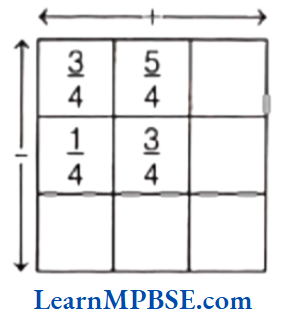
Solution. Here, \(\frac{3}{4}+\frac{5}{4}=\frac{3+5}{4}=\frac{8}{4}=2 \text { and } \frac{1}{4}+\frac{3}{4}=\frac{1+3}{4}=\frac{4}{4}=1\)
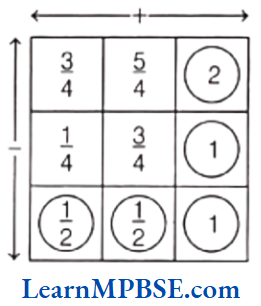
Now, \(\frac{3}{4}-\frac{1}{4}=\frac{3-1}{4}=\frac{2}{4}=\frac{1}{2}\)
and \(\frac{5}{4}-\frac{3}{4}=\frac{5-3}{4}=\frac{2}{4}=\frac{1}{2}\)
Also, we have 2 – 1 = 1
and \(\frac{1}{2}+\frac{1}{2}=\frac{1+1}{2}=\frac{2}{2}=1\)
Hence, the required complete box is shown above.
Addition and Subtraction of Mixed Fractions
Firstly, we convert both mixed fractions into improper fractions and then add them by converting into equivalent fractins with the same denominator.
To subtract mixed fractions, we subtract smaller whole part from greater whole part and then subtract corresponding fractional parts.
Mixed fractions cab be written either as a whole part plus a proper fraction or entirely as an improper fraction. One way to add (or subtract) mixed fractions is to do the operation separately for the whole parts and other way is to write the mixed fractions as improper fractions and then directly add (or subtract) them.
Class 6 Mp Board Maths Question Answers
Example 7. Add \(2 \frac{2}{5}\) and \(3 \frac{5}{6}\).
Solution. We have, \(2 \frac{2}{5}\) and \(3 \frac{5}{6}\)
To add mixed fractions, first convert both mixed fractions into improper fractions.
Now, \(2 \frac{2}{5}=\frac{12}{5} \text { and } 3 \frac{5}{6}=\frac{23}{6}\)
⇒ \(2 \frac{2}{5}+3 \frac{5}{6}=\frac{12}{5}+\frac{23}{6}\)
Now, converting them into equivalent fractions with the same denominator.
We have, \(\frac{12}{5}=\frac{12 \times 6}{5 \times 6}=\frac{72}{30} \text { and } \frac{23}{6}=\frac{23 \times 5}{6 \times 5}=\frac{115}{30}\) [LCM of 5 and 6 is 30]
∴ \(2 \frac{2}{5}+3 \frac{5}{6}=\frac{72}{30}+\frac{115}{30}=\frac{187}{30}=6 \frac{7}{30}\)
Example 8. Subtract \(3 \frac{5}{9}\) from \(5 \frac{1}{6}\).
Solution. We have, \(3 \frac{5}{9}\) and \(5 \frac{1}{6}\)
To subtract mixed fractions, first convert both mixed fractions into improper fractions.
∴ \(5 \frac{1}{6}-3 \frac{5}{9}=\frac{31}{6}-\frac{32}{9}\)
= \(\frac{31 \times 3}{6 \times 3}-\frac{32 \times 2}{9 \times 2}=\frac{93}{18}-\frac{64}{18}\)
= \(\frac{93-64}{18}=\frac{29}{18}\) [∴ LCM of 6 and 9 is 18]
⇒ \(5 \frac{1}{6}-3 \frac{5}{9}=1 \frac{11}{18}\)
Example 9. Simplify \(3 \frac{1}{3}+6 \frac{2}{3}-2 \frac{2}{3}\)
Solution. \(\left(3+\frac{1}{3}\right)+\left(6+\frac{2}{3}\right)-\left(2+\frac{2}{3}\right)\)
= \(\frac{(3 \times 3)+1}{3}+\frac{(6 \times 3)+2}{3}-\frac{(3 \times 2)+2}{3}\)
= \(\frac{10}{3}+\frac{20}{3}-\frac{8}{3}=\frac{10+20-8}{3}=\frac{30-8}{3}=\frac{22}{3}\)
Example 10. What should be added to \(7 \frac{4}{15}\) to get \(8 \frac{2}{5}\)
Solution. Let x be added to the \(7 \frac{4}{15}\),
i.e. \(7 \frac{4}{15}+x=8 \frac{2}{5}\)
⇒ \(\frac{109}{15}+x=\frac{42}{5}\)
⇒ \(x=\frac{42}{5}-\frac{109}{15}=\frac{126-109}{15}\)
[∴ LCM of 5 and 15 = 15]
∴ \(x=\frac{17}{15}=1 \frac{2}{15}\)
Example 11. Rahul was given \(1 \frac{1}{5}\) piece of bread and Garima was given \(1 \frac{1}{4}\) piece of bread. Find the total amount of bread was given to both of them.
Solution. Bread given to Rahul = \(1 \frac{1}{5}\) piece
Bread given to Garima = \(1 \frac{1}{4}\) piece.
Total bread given to both of them = \(1 \frac{1}{5}+1 \frac{1}{4}\)
= \(\frac{5 \times 1+1}{5}+\frac{4 \times 1+1}{4}=\frac{6}{5}+\frac{5}{4}\)
LCM of 5 and 4 = 20
∴ \(\frac{6}{5}+\frac{5}{4}=\frac{6 \times 4}{5 \times 4}+\frac{5 \times 5}{4 \times 5}=\frac{24}{20}+\frac{25}{20}=\frac{24+25}{20}=\frac{49}{20}\)
Hence, total bread given to both of them = \(\frac{49}{20}\)
Class 6 Mp Board Maths Question Answers
Example 12. Add the difference of \(1 \frac{3}{4}\) and \(\frac{4}{5}\) to the sum of \(\frac{3}{5}\) and \(\frac{2}{7}\).
Solution. We have, \(1 \frac{3}{4}-\frac{4}{5} \text { and } \frac{3}{5}+\frac{2}{7}\)
Now, \(\frac{7}{4}-\frac{4}{5}=\frac{35-16}{20}=\frac{19}{20} \text { and } \frac{3}{5}+\frac{2}{7}=\frac{21+10}{35}=\frac{31}{35}\)
Now, according to the question, \frac{19}{30}+\frac{31}{35}
∴ LCM of 20 and 35 = 140
∴ \(\frac{19 \times 7}{20 \times 7}+\frac{31 \times 4}{35 \times 4}=\frac{133}{140}+\frac{124}{140}=\frac{133+124}{140}=\frac{257}{140}=1 \frac{117}{140}\)
Example 13. Savita bought \(\frac{2}{5}\) m of ribbon and Kavita bought \(\frac{3}{4}\) m of the ribbon. What was the total length of the ribbon they bought?
Solution. The ribbon bought by Savita = \(\frac{2}{5}\) m
The ribbon bought by Kavita = \(\frac{3}{4}\) m
∴ Total ribbon bought by them = \(\frac{3}{4}+\frac{2}{5}\)
LCM of 4 and 5 = 20
∴ \(\frac{3}{4}+\frac{2}{5}=\frac{3 \times 5}{4 \times 5}+\frac{2 \times 4}{5 \times 4}=\frac{15}{20}+\frac{8}{20}=\frac{23}{20} \mathrm{~m}\)
Hence, total ribbon bought by both = \(\frac{23}{20}\) m
Chapter 7 Fractions Exercise 7.1
Question 1. Write the fraction representing the shaded portion.
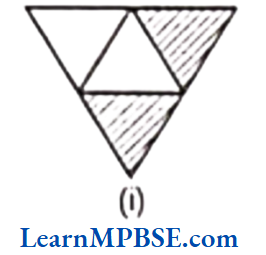
Solution.
Total number of equal parts = 4;
Shaded parts = 2
∴ Fraction representing the shaded portion \(=\frac{\text { Number of shaded parts }}{\text { Total number of equal parts }}=\frac{2}{4}=\frac{1}{2}\)
Mp Board Class 6 Book Solutions
Question 2. Colour the part according to the given fraction.
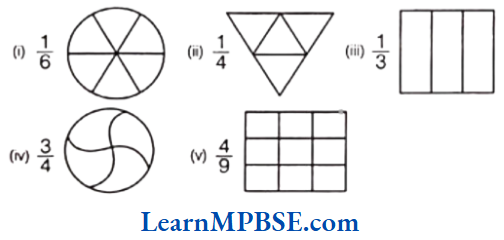
Solution. (1) Here, fraction 1/6 shows that out of 6 equal parts, 1 part is shaded. So, the required figure is shown alongside.
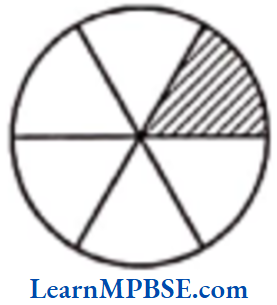
(2) Here, fraction 1/4 shows that out of 4 equal parts, 1 part is shaded. So, the required figure is shown alongside.
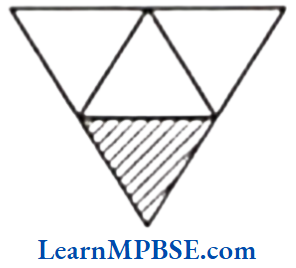
(3) Here, fraction 1/3 shows that out of 3 equal parts, 1 part is shaded. So, the required figure is shown alongside.
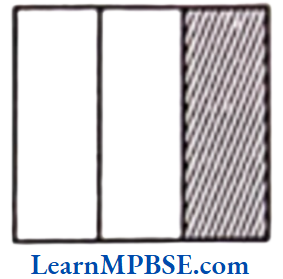
(4) Here, fraction 3/4 shows that out of 4 equal parts, 3 parts are shaded. So, the required figure is shown along side.

(5) Here, fraction \frac{4}{9} shows that out of 9 equal parts, 4 parts are shaded. So, the required figure is shown along side.
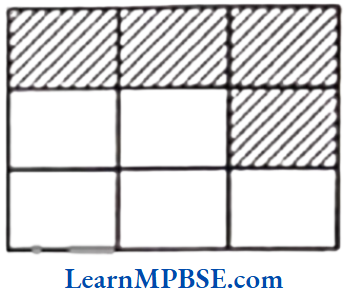
Question 3. Identify the error if any.
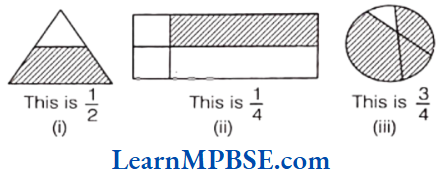
Solution. (1) In the given figure, shaded portion is not equal to unshaded portion. So, fraction is not equal to 1/2.
(2) In the given figure, four parts are not equal.
∴ Fraction is not equal to 1/4.
(3) In the given figure, four parts are not equal.
∴ Fraction is not equal to 3/4.
Mp Board Class 6 Book Solutions
Question 4. What fraction of a day is 8 hours?
Solution. We know that total hours in a day = 24 h
∴ Required fraction \(=\frac{8 \mathrm{~h}}{24 \mathrm{~h}}=\frac{8}{24}=\frac{1}{3}\)
Question 5. What fraction of an hour is 40 minutes?
Solution. We know that total minutes in an hour = 60 min
∴ Required fraction \(=\frac{40 \mathrm{~min}}{60 \mathrm{~min}}=\frac{40}{60}=\frac{2}{3}\)
Question 6. Arya, Abhimanyu and Vivek shared lunch. Arya has brought two sandwiches, one made of vegetable and one of jam. The other two boys forgot to bring their lunch. Arya agreed to share his sandwiches, so that each person will have an equal share of each sandwich.
(1) How can Arya divide his sandwiches, so that each person has an equal share?
(2) What part of a sandwich will each boy receive?
Solution. Total number of sandwiches = 2
Total number of boys = 3
(1) Here, Arya has to divide 2 sandwiches into 3 persons. So, he will divide each sandwich into three equal parts and give one part of each sandwich to each of them.
Thus, each person gets 2/3 sandwiches.
(2) One sandwich is to be divided among three boys.
∴ Each boy will get = 1/3 part of a sandwich.
Types of Fractions Class 6
Question 7. Kanchan dyes dresses. She had to dye 30 dresses. She has so far finished 20 dresses. What fraction of dresses has she finished?
Solution. Total number of dresses to be dyed = 30
Number of dresses finished = 20
∴ Required fraction of finished dresses \(=\frac{\text { Number of dress finished }}{\text { Total number of dresses }}=\frac{20}{30}=\frac{2}{3}\)
Question 8. Write the natural numbers from 2 to 12. What fraction of them are prime numbers?
Solution. Natural numbers from 2 to 12=2, 3, 4, 5, 6, 7, 8, 9, 10, 11, 12
Total natural numbers = 11
Prime numbers from 2 to 12 = 2, 3, 5, 7, 11
Total prime numbers = 5
∴ Required fraction \(=\frac{\text { Total prime numbers }}{\text { Total natural numbers }}=\frac{5}{11}\)
Question 9. What fraction of these circles have X in them?
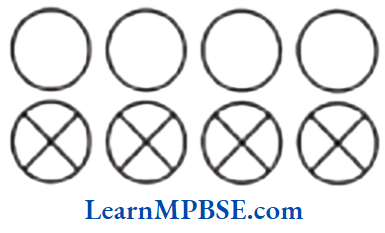
Solution. Total number of circles = 8; Number of circles having X = 4
∴ Required fraction \(=\frac{\text { Number of circles having } X}{\text { Total number of circles }}\)
= \(\frac{4}{8}\) = \(\frac{1}{2}\)
Mp Board Class 6 Book Solutions
Question 10. Kristin received a CD player for her birthday. She bought 3 CDs and received 5 others as gifts. What fraction of her total CDs did she buy and what fraction did she receive as gifts?
Solution. Number of CDs bought by Kristin = 3
Number of CDs recived as gifts = 5
∴ Total number of CDs = 3 + 5 = 8
Hence, the fraction of CDs bought by Kristin
\(=\frac{\text { Number of CDs bought by Kristin }}{\text { Total number of CDs }}=\frac{3}{8}\)and fraction of CDs, she received as gifts
\(=\frac{\text { Number of CDs recieved as gift }}{\text { Total number of CDs }}=\frac{5}{8}\)Question 11. Show 3/5 on a number line.
Solution. We know that 3/5 is greater than zero but less than 1. So, it will lie between 0 and 1.
Since, we have to show 3/5, so we have to divide the gap between 0 and 1 into five equal parts. Then, each part shows 1/5 and 3 parts will show 3/5.
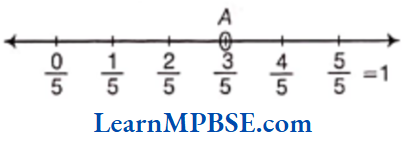
[also, \(\frac{0}{5}\) = 0]
Hence, point A represents 3/5.
Question 12. Show \(\frac{1}{10}\), \(\frac{0}{10}\), \(\frac{5}{10}\) and \(\frac{10}{10}\) on a number line.
Solution. We know that all given fractions are greater than or equal to zero but less than or equal to 1.
So, we have to divide the gap between 0 and 1 into ten equal parts, then each part shows \(\frac{1}{10}\) and 5 parts show \(\frac{5}{10}\), 10 parts show \(\frac{10}{10}\). Also, 0 shows \(\frac{0}{10}\)

[also, \(\frac{0}{10}\) = 0]
Hence, points A, B, C and D represent the fractions \(\frac{0}{10}, \frac{1}{10}, \frac{5}{10} \text { and } \frac{10}{10}\) and respectively.
Mp Board Class 6 Maths Solutions
Question 13. Can you show any other fraction between 0 and 1? Write five more fractions that you can show and depict them on the number line.
Solution. Yes, we can show many other fractions which are greater than 0 and less than 1 i.e. between 0 and 1.
Five other fractions are \(\frac{1}{8}, \frac{2}{8}, \frac{3}{8}, \frac{4}{8} \text { and } \frac{5}{8}\)
These fractions are shown on a number line as given below

Here, points A, B, C, D and E represent \(\frac{1}{8}, \frac{2}{8}, \frac{3}{8}, \frac{4}{8} \text { and } \frac{5}{8}\) respectively.
Question 14. How many fractions lle between 0 and 1? Think, discuss and write your answer?
Solution. There are infinite number of points between 0 and 1 on the number line. So, there are infinite number of fractions lie between 0 and 1.
Question 15. Give a proper fraction,
(1) whose numerator is 5 and denominator is 7.
(2) whose denominator is 9 and numerator is 5.
(3) whose numerator and denominator add upto 10. How many fractions of this kind can you make?
(4) whose denominator is 4 more than the numerator.
Give any five. How many more can you make?
Solution. (1) Numerator = 5 and denominator = 7
∴ Required fraction = \(\frac{5}{7}\)
(2) Numerator = 5 and denominator = 9
∴ Required fraction = \(\frac{5}{9}\)
(3) Possible pairs of numerator and denominator which add upto 10 are (0,10), (1, 9), (2, 8), (3, 7) and (4, 6).
Now, proper fractions = \(\frac{0}{10}, \frac{1}{9}, \frac{2}{8}, \frac{3}{7} \text { and } \frac{4}{6}\)
There are five fractions. So, we can make five such fractions.
(4) There can be infinite number of fractions whose denominator is 4 more than the numerator. Some of them are \(\frac{0}{4}, \frac{1}{5}, \frac{2}{6}, \frac{3}{7} \text { and } \frac{4}{8}\)
Mp Board Class 6 Maths Solutions
Chapter 7 Fractions Exercise 7.2
Question 1. Draw number lines and locate the points on them.
(1) \(\frac{1}{2}\), \(\frac{1}{4}\), \(\frac{3}{4}\), \(\frac{4}{4}\)
(2) \(\frac{1}{8}\), \(\frac{2}{8}\), \(\frac{3}{8}\), \(\frac{7}{8}\)
(3) \(\frac{2}{5}\), \(\frac{3}{5}\), \(\frac{8}{5}\), \(\frac{4}{5}\)
Solution. Here, fractions are \(\frac{1}{2}\), \(\frac{1}{4}\), \(\frac{3}{4}\), \(\frac{4}{4}\). Also, \(\frac{1}{2}=\frac{1 \times 2}{2 \times 2}=\frac{2}{4}\)
Now, draw a number line, mark two points 0 and 1 on it. Divide the gap between 0 and 1 into four equal parts because denominator is 4, then each part will show \(\frac{1}{4}\). Also, 2 parts show \(\frac{2}{4}\), 3 parts show \(\frac{3}{4}\) and 4 parts show \(\frac{4}{4}\).

Hence, A, B, C and D represent \(\frac{1}{4}\), \(\frac{2}{4}\), \(\frac{3}{4}\) and \(\frac{4}{4}\) respectively.
Here, fractions are \(\frac{1}{8}\), \(\frac{2}{8}\), \(\frac{3}{8}\) and \(\frac{7}{8}\).
Now, draw a number line, mark two points 0 and 1 on it. Divide the gap between 0 and 1 into eight equal parts because denominator is 8, then each part will show \(\frac{1}{8}\). Also, 2 parts show \(\frac{2}{8}\), 3 parts show \(\frac{3}{8}\) and 7 parts show \(\frac{7}{8}\).

Hence, A, B, C and D represent \(\frac{1}{8}\), \(\frac{2}{8}\), \(\frac{3}{8}\) and \(\frac{7}{8}\) respectively.
(3) Here, fractions are \(\frac{2}{5}\), \(\frac{3}{5}\), \(\frac{4}{5}\) and \(\frac{8}{5}\).
Now, draw a number line, mark two points 0 and 1 on it. Divide the gap between 0 and 1 into five equal parts because denominator is 5, then each part will show \(\frac{1}{5}\).
Also, 2 parts show \(\frac{2}{5}\), 3 parts show \(\frac{3}{5}\), 4 parts show \(\frac{4}{5}\) and \(\frac{8}{5}\) lies between 2 and 2.

Hence, A, B, C and D represent \(\frac{2}{5}\), \(\frac{3}{5}\), \(\frac{4}{5}\) and \(\frac{8}{5}\) respectively.
Question 2. Express the following as mixed fractions.
(1) \(\frac{20}{3}\)
(2) \(\frac{11}{5}\)
Solution. (1) We have, \(\frac{20}{3}\)
On dividing 20 by 3, we get quotient = 6, remainder = 2
∴ \(\frac{20}{3}\) = \(6 \frac{2}{3}\) i.e. 6 whole and \(\frac{2}{3}\) more
(2) We have, \(\frac{11}{5}\)
On dividing 11 by 5, we get quotient = 2, remainder = 1
∴ \(\frac{11}{5}\) = \(2 \frac{1}{5}\) i.e. 2 whole and \(\frac{1}{5}\) more
Mp Board Class 6 Maths Solutions
Question 3. Express the following as improper fractions.
(1) \(7 \frac{3}{4}\)
(2) \(5 \frac{6}{7}\)
(3) \(2 \frac{5}{6}\)
(4) \(10 \frac{3}{5}\)
(5) \(9 \frac{3}{7}\)
(6) \(8 \frac{4}{9}\)
Solution. (1) \(7 \frac{3}{4}=7+\frac{3}{4}=\frac{7 \times 4+3}{4}=\frac{31}{4}\)
(2) \(5 \frac{6}{7}=5+\frac{6}{7}=\frac{5 \times 7+6}{7}=\frac{41}{7}\)
(3) \(2 \frac{5}{6}=2+\frac{5}{6}=\frac{2 \times 6+5}{6}=\frac{17}{6}\)
(4) \(10 \frac{3}{5}=10+\frac{3}{5}=\frac{10 \times 5+3}{5}=\frac{53}{5}\)
(5) \(9 \frac{3}{7}=9+\frac{3}{7}=\frac{9 \times 7+3}{7}=\frac{66}{7}\)
(6) \(8 \frac{4}{9}=8+\frac{4}{9}=\frac{8 \times 9+4}{9}=\frac{76}{9}\)
Question 4. Are \(\frac{1}{3}\) and \(\frac{2}{7}\); \(\frac{2}{5}\) and \(\frac{2}{7}\); \(\frac{2}{9}\) and \(\frac{6}{27}\) equivalent? Give reason.
Solution. (1) \(\frac{1}{3}\) and \(\frac{2}{7}\)
Here, 1 x 7 = 7 and 3 x 2 = 6
∴ 7 ≠ 6, So \(\frac{1}{3}\) and \(\frac{2}{7}\) are not equivalent fractions.
(2) \(\frac{2}{5}\) and \(\frac{2}{7}\)
Here, 2 x 7 = 14 and 5 x 2 = 10
∴ 14 ≠ 10, so \(\frac{2}{5}\) and \(\frac{2}{7}\) are not equivalent fractions.
(3) \(\frac{2}{9}\) and \(\frac{6}{27}\)
Here, 2 x 27 = 54 and 9 x 6 = 54
∴ 54 = 54, so \(\frac{2}{9}\) and \(\frac{6}{27}\) are equivalent fractions.
Question 5. Give examples of four equivalent fractions.
Solution. Four equivalent fractions are \(\frac{1}{2}, \frac{2}{4}, \frac{3}{6}, \frac{4}{8},\) etc.
Mp Board Class 6 Maths Solutions
Question 6. Find five equivalent fractions of each of the following.
(1) \(\frac{2}{3}\)
(2) \(\frac{1}{5}\)
Solution. (1) Five equivalent fractions of \(\frac{2}{3}\) are as follows.
\(\frac{2}{3}=\frac{2 \times 2}{3 \times 2}=\frac{4}{6} ; \frac{2}{3}=\frac{2 \times 3}{3 \times 3}=\frac{6}{9} ; \frac{2}{3}=\frac{2 \times 4}{3 \times 4}=\frac{8}{12}\) \(\frac{2}{3}=\frac{2 \times 5}{3 \times 5}=\frac{10}{15} ; \frac{2}{3}=\frac{2 \times 6}{3 \times 6}=\frac{12}{18}\)Thus, five equivalent fractions of \(\frac{2}{3}\) are \(\frac{4}{6}, \frac{6}{9}, \frac{8}{12}, \frac{10}{15}\) and \(\frac{12}{18}\).
(2) Five equivalent fractions of \(\frac{1}{5}\) are as follows.
\(\frac{1}{5}=\frac{1 \times 2}{5 \times 2}=\frac{2}{10} ; \frac{1}{5}=\frac{1 \times 3}{5 \times 3}=\frac{3}{15} ;\) \(\frac{1}{5}=\frac{1 \times 4}{5 \times 4}=\frac{4}{20} ; \frac{1}{5}=\frac{1 \times 5}{5 \times 5}=\frac{5}{25},\) \(\frac{1}{5}=\frac{1 \times 6}{5 \times 6}=\frac{6}{30}\)Thus, five equivalent fractions of \(\frac{1}{5}\) are \(\frac{2}{10}, \frac{3}{15}, \frac{4}{20}, \frac{5}{25}\) and \(\frac{6}{30}\).
Question 7. Write the simplest form of:
(1) \(\frac{15}{75}\)
(2) \(\frac{16}{72}\)
Solution. (1) We have, \(\frac{15}{75}\)
Now, factors of 15 = 3 x 5
and factors of 75 = 3 x 5 x 5
Common factors = 3 and 5
∴ HCF of 15 and 75 = 3 x 5 = 15
Then, \(\frac{15}{75}=\frac{15+15}{75+15}=\frac{1}{5}\)
Hence, fraction \(\frac{1}{5}\) is the simplest form of given fraction.
(2) We have, \(\frac{16}{72}\)
Now, factors of 16 = 2 x 2 x 2 x 2
and factors of 72 = 2 x 2 x 2 x 3 x 3
Common factors = 2, 2 and 2
∴ HCF of 16 and 72 = 2 x 2 x 2 = 8
Then, \(\frac{16}{72}=\frac{16 \div 8}{72 \div 8}=\frac{2}{9}\)
Hence, fraction \(\frac{2}{9}\) is the simplest form of given fraction.
Class 6 Maths Chapter 7 Solutions Mp Board
Question 8. Is \(\frac{49}{64}\) in its simplest form?
Solution. Here, factors of 49 = 7 x 7 and factors of 64 = 8 x 8
∴ 49 and 64 have no common factor except 1.
Hence, fraction \(\frac{49}{64}\) is in simplest form.
Chapter 7 Fractions Exercise 7.3
Question 1. Write the fractions. Are all these fractions equivalent?
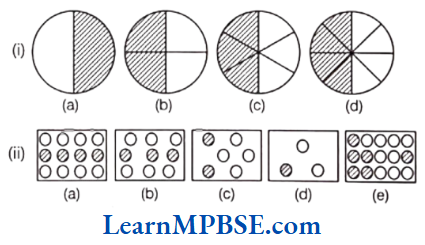
Solution. (1) (a) Total number of equal parts = 2
Number of shaded parts = 1
∴ Fraction of shaded portion \(=\frac{\text { Number of shaded parts }}{\text { Total number of equal paarts }}=\frac{1}{2}\)
(b) Total number of equal parts = 4;
Number of shaded parts = 2
∴ Fraction of shaded portion = \(\frac{2}{4}\)
(c) Total number of equal parts = 6;
Number of shaded parts = 3
∴ Fraction of shaded portion = \(\frac{3}{6}\)
(d) Total number of equal parts = 8;
Number of shaded parts = 4
∴ Fraction of shaded portion = \(\frac{4}{8}\)
Now, \(\frac{2}{4}=\frac{2+2}{4 \div 2}=\frac{1}{2}\) [∴ HCF of 2 and 4 is 2]
\(\frac{3}{6}=\frac{3 \div 3}{6+3}=\frac{1}{2}\) [∴ HCF of 3 and 6 is 3]
\(\frac{4}{8}=\frac{4 \div 4}{8 \div 4}=\frac{1}{2}\) [∴ HCF of 4 and 8 is 4]
Since, all fractions in simplest form are same.
∴ \(\frac{1}{2}=\frac{2}{4}=\frac{3}{6}=\frac{4}{8}\) i.e. the fractions are equivalent.
(2) (a) Total number of equal parts = 12;
Number of shaded parts = 4
∴ Fraction of shaded portion = \(\frac{4}{12}\)
(b) Total number of equal parts = 9;
Number of shaded parts = 3
∴ Fraction of shaded portion = \(\frac{3}{9}\)
(c) Total number of equal parts = 6;
Number of shaded parts = 2
∴ Fraction of shaded portion = \(\frac{1}{3}\)
(d) Total number of equal parts = 3;
Number of shaded parts = 1
∴ Fraction of shaded portion = \(\frac{1}{3}\)
(e) Total number of equal parts = 15;
Number of shaded parts = 6
∴ Fraction of shaded portion = \(\frac{6}{15}\)
Now, \(\frac{4}{12}=\frac{4 \div 4}{12 \div 4}=\frac{1}{3}\) [∴ HCF of 4 and 12 is 4]
\(\frac{3}{9}=\frac{3+3}{9+3}=\frac{1}{3}\) [∴ HCF of 3 and 9 is 3]
\(\frac{2}{6}=\frac{2+2}{6+2}=\frac{1}{3}\) [∴ HCF of 2 and 6 is 2]
\(\frac{6}{15}=\frac{6+3}{15+3}=\frac{2}{5}\) [∴ HCF of 6 and 15 is 3]
Here, except \(\frac{6}{15}\) all the fractions in simplest form are same.
Question 2. Find the equivalent fraction of \(\frac{3}{5}\) having
(1) denominator 20
(2) numerator 9
Solution. Let N stands for the numerator and D stands for the denominator.
(1) Given, denominator of an equivalent fraction = 20
∴ \(\frac{N}{20}\) = \(\frac{3}{5}\) ⇒ N x 5 = 20 x 3
So, N x 5 = 4 x 5 x 3 [∴ 20 = 4 x 5]
⇒ N x 5 = 12 x 5
On comparing, we get N = 12
∴ Required equivalent fraction of \(\frac{3}{5}=\frac{N}{D}=\frac{12}{20}\)
(2) Given, numerator of an equivalent fraction = 9
∴ \(\frac{9}{D}\) = \(\frac{3}{5}\) ⇒ D x 3 = 9 x 5
So, D x 3 = 3 x 3 x 5 [∴ 9 = 3 x 3]
⇒ D x 3 = 15 x 3
On comparing, we get D = 15
∴ Required equivalent fraction of \(\frac{3}{5}=\frac{N}{D}=\frac{9}{15}\)
Class 6 Maths Chapter 7 Solutions Mp Board
Question 3. Check whether the given fractions are equivalent.
(1) \(\frac{5}{9}\), \(\frac{30}{54}\)
(2) \(\frac{3}{10}\), \(\frac{12}{50}\)
(3) \(\frac{7}{13}\), \(\frac{5}{11}\)
Solution.
(1) We have, \(\frac{5}{9}\) and \(\frac{30}{54}\)
Now, 5 x 54 = 270; 9 x 30 = 270 [by cross-product]
∴ 270 = 270
∴ \(\frac{5}{9}\) and \(\frac{30}{54}\) are equivalent fractions.
(2) We have, \(\frac{3}{10}\) and \(\frac{12}{50}\)
Now, 3 x 50 = 150; 10 x 12 = 120 [by cross-product]
But 150 ≠ 120
∴ \(\frac{3}{10}\) and \(\frac{12}{50}\) are not equivalent fractions.
(3) We have, \(\frac{7}{13}\) and \(\frac{5}{11}\)
Now, 7 x 11 = 77; 13 x 5 = 65 [by cross-product]
But 77 ≠ 65
∴ \(\frac{7}{13}\) and \(\frac{5}{11}\) are not equivalent fractions.
Question 4. Reduce the following fractions to simplest form.
(1) \(\frac{48}{60}\)
(2) \(\frac{150}{60}\)
Solution. (1) We have, \(\frac{48}{60}\)
Now, factors of 48 = 2, 2, 2, 2, 3
and factors of 60 = 2, 2, 3, 5
Common factors = 2, 2 and 3
HCF of 48 and 60 = 2 x 2 x 3 = 12
∴ \(\frac{48}{60}=\frac{48+12}{60+12}=\frac{4}{5}\)
Hence, the simplest form of the fraction \(\frac{48}{60}\) is \(\frac{4}{5}\).
(2) We have, \(\frac{150}{60}\)
Now, factors of 150 = 2, 3, 5, 5
and factors of 60 = 2, 2, 3, 5
Common factors = 2, 3 and 5
HCF of 150 and 60 = 2 x 3 x 5 = 30
∴ \(\frac{150}{60}=\frac{150+30}{60+30}=\frac{5}{2}\)
Hence, the simplest form of the fraction \(\frac{150}{60}\) is \(\frac{5}{2}\).
Class 6 Maths Chapter 7 Solutions Mp Board
Question 5. Ramesh had 20 pencils, Sheelu had 50 pencils and Jamaal had 80 pencils. After 4 months, Ramesh used up 10 pencils, Sheelu used up 25 pencils and Jamaal used up 40 pencils. What fraction did each used up? Check if each has used up an equal fraction of her/his pencils?
Solution. Here, the fraction of pencils used by Ramesh = \(\frac{10}{20}\)
Fraction of pencils used by Sheelu = \(\frac{25}{50}\)
Fraction of pencils used by Jamaal = \(\frac{40}{80}\)
Now, \(\frac{10}{20}=\frac{10 \div 10}{20 \div 10}=\frac{1}{2}\) [∴ HCF of 10 and 20 is 10]
\(\frac{25}{50}=\frac{25 \div 25}{50 \div 25}=\frac{1}{2}\) [∴ HCF of 25 and 50 is 25]
and \(\frac{40}{80}=\frac{40 \div 40}{80 \div 40}=\frac{1}{2}\) [∴ HCF of 40 and 80 is 40]
Thus, \(\frac{10}{20}=\frac{25}{50}=\frac{40}{80}=\frac{1}{2}\)
Question 6. You get one-fifth of a bottle of juice and your sister gets one-third of the same size of a bottle of juice. Who gets more?
Solution. Here, we will compare one-fifth i.e. \(\frac{1}{5}\) and one-third i.e. \(\frac{1}{3}\).
Since \(\frac{1}{5}\) and \(\frac{1}{3}\) have same numerator, so the fraction with smaller denominator is greater.
Thus, \(\frac{1}{3}\) > \(\frac{1}{5}\)
Thus, your sister gets more juice.
Question 7. Write these is ascending and also in descending order.
(1) \(\frac{1}{8}, \frac{5}{8}, \frac{3}{8}\)
Solution. (1) We have, \(\frac{1}{8}, \frac{5}{8}, \frac{3}{8}\)
Here, denominators of all fractions are same.
∴ Ascending order of numerators = 1 < 3 < 5
and descending order of numerators = 5 > 3 > 1
∴ Ascending order of fractions = \(\frac{1}{8}<\frac{3}{8}<\frac{5}{8}\)
and descending order of fractions = \(\frac{5}{8}>\frac{3}{8}>\frac{1}{8}\)
Question 8. Arrange the following in ascending and descending order.
(1) \(\frac{1}{12}, \frac{1}{23}, \frac{1}{5}, \frac{1}{7}, \frac{1}{50}, \frac{1}{9}, \frac{1}{17}\)
(2) \(\frac{3}{7}, \frac{3}{11}, \frac{3}{5}, \frac{3}{2}, \frac{3}{13}, \frac{3}{4}, \frac{3}{17}\)
(3) Write 3 more similar examples and arrange them in ascending and descending order.
Solution. (1) Here, numerators of all fractions are same.
Descending order of denominators = 50 > 23 > 17 > 12 > 9 > 7 > 5
∴ Ascending order of fractions = \(\frac{1}{50}<\frac{1}{23}<\frac{1}{17}<\frac{1}{12}<\frac{1}{9}<\frac{1}{7}<\frac{1}{5}\)
[∴ \(\frac{1}{50}\) has larger denominator, so it is smallest fraction]
and descending order of fractions = \(\frac{1}{5}>\frac{1}{7}>\frac{1}{9}>\frac{1}{12}>\frac{1}{17}>\frac{1}{23}>\frac{1}{50}\)
(2) Here, numerators of all fractions are same.
Descending order of denominators = 17 > 13 > 11 > 7 > 5 > 4 > 2
∴ Ascending order of fractions = \(\frac{3}{17}<\frac{3}{13}<\frac{3}{11}<\frac{3}{7}<\frac{3}{5}<\frac{3}{4}<\frac{3}{2}\)
and descending order of fractions = \(\frac{3}{2}>\frac{3}{4}>\frac{3}{5}>\frac{3}{7}>\frac{3}{11}>\frac{3}{13}>\frac{3}{17}\)
(3) Three more similar examples can be taken as
(a) \(\frac{2}{11}, \frac{2}{21}, \frac{2}{9}, \frac{2}{7}, \frac{2}{8}, \frac{2}{15}\)
Here, descending order of denominators = 21 > 15 > 11 > 9 > 8 > 7
∴ Ascending order of fractions = \(\frac{2}{21}<\frac{2}{15}<\frac{2}{11}<\frac{2}{9}<\frac{2}{8}<\frac{2}{7}\)
and descending order of fractions = \(\frac{2}{7}>\frac{2}{8}>\frac{2}{9}>\frac{2}{11}>\frac{2}{15}>\frac{2}{21}\)
(b) \(\frac{4}{5}, \frac{4}{6}, \frac{4}{13}, \frac{4}{2}, \frac{4}{9}, \frac{4}{11}\)
Here, descending order of denominators = 13 > 11 > 9 > 6 > 5 > 2
∴ Ascending order of fractions = \(\frac{4}{13}<\frac{4}{11}<\frac{4}{9}<\frac{4}{6}<\frac{4}{5}<\frac{4}{2}\)
and descending order of fractions = \(\frac{4}{2}>\frac{4}{5}>\frac{4}{6}>\frac{4}{9}>\frac{4}{11}>\frac{4}{13}\)
(c) \(\frac{7}{11}, \frac{7}{13}, \frac{7}{5}, \frac{7}{2}, \frac{7}{3}, \frac{7}{4}\)
Here, descending order of denominators = 13 > 11 > 5 > 4 > 3 > 2
∴ Ascending order of fractions = \(\frac{7}{13}<\frac{7}{11}<\frac{7}{5}<\frac{7}{4}<\frac{7}{3}<\frac{7}{2}\)
and descending order of fractions = \(\frac{7}{2}>\frac{7}{3}>\frac{7}{4}>\frac{7}{5}>\frac{7}{11}>\frac{7}{13}\)
Chapter 7 Fractions Exercise 7.4
Question 1. Write shaded portion as fraction. Arrange them in ascending and descending order using correct sign ‘<‘, ‘=’, ‘>’ between the fractions.
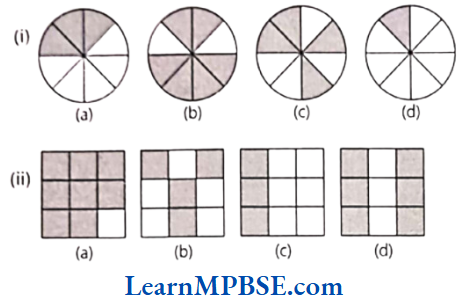
Solution. (1) Here, the total number of equal parts in all figures = 8
Shaded portion of figure (a) represents fraction = \(\frac{3}{8}\)
Shaded portion of figure (b) represents fraction = \(\frac{6}{8}\)
Shaded portion of figure (c) represents fraction = \(\frac{4}{8}\)
Shaded portion of figure (d) represents fraction = \(\frac{1}{8}\)
∴ Denominators of all fractions are same. So, we arrange them in ascending and descending order according to their numerators.
∴ Ascending order of fractions = \(\frac{1}{8}<\frac{3}{8}<\frac{4}{8}<\frac{6}{8}\)
[∴ fraction having small numerator will be smaller]
and descending order of fractions = \(\frac{6}{8}>\frac{4}{8}>\frac{3}{8}>\frac{1}{8}\)
[∴ fraction having greatest numerator will be greatest]
(2) Here, the total number of equal parts in all figures = 9
Shaded portion of figure (a) represents fraction = \(\frac{8}{9}\)
Shaded portion of figure (b) represents fraction = \(\frac{4}{9}\)
Shaded portion of figure (c) represents fraction = \(\frac{3}{9}\)
Shaded portion of figure (d) represents fraction = \(\frac{6}{9}\)
∴ Denominators of all fractions are same. So, we arrange them in ascending and descending order according to their numerators.
∴ Ascending order of fractions = \(\frac{3}{9}<\frac{4}{9}<\frac{6}{9}<\frac{8}{9}\)
and descending order of fractions = \(\frac{8}{9}>\frac{6}{9}>\frac{4}{9}>\frac{3}{9}\)
Class 6 Maths Chapter 7 Solutions Mp Board
Question 2. The following fractions represent just three different numbers. Separate them into three groups of equivalent fractions, by changing each one to its simplest form.
(1) \(\frac{2}{12}\)
(2) \(\frac{3}{15}\)
(3) \(\frac{8}{50}\)
(4) \(\frac{16}{100}\)
(5) \(\frac{10}{60}\)
(6) \(\frac{15}{75}\)
(7) \(\frac{12}{60}\)
(8) \(\frac{16}{96}\)
(9) \(\frac{12}{75}\)
(10) \(\frac{12}{72}\)
(11) \(\frac{3}{18}\)
(12) \(\frac{4}{25}\)
Solution. First, we have to convert all the fractions in its simplest form.
(1) We have, \(\frac{2}{12}\) ⇒ \(\frac{2 \div 2}{12 \div 2}=\frac{1}{6}\) [∴ HCF of 2 and 12 = 2]
(2) We have, \(\frac{3}{15}\) ⇒ \(\frac{3 \div 3}{15 \div 3}=\frac{1}{5}\) [∴ HCF of 3 and 15 = 3]
(3) We have, \(\frac{8}{50}\) ⇒ \(\frac{8 \div 2}{50 \div 2}=\frac{4}{25}\) [∴ HCF of 8 and 50 = 2]
(4) We have, \(\frac{16}{100}\) ⇒ \(\frac{16 \div 4}{100 \div 4}=\frac{4}{25}\) [∴ HCF of 16 and 100 = 4]
(5) We have, \(\frac{10}{60}\) ⇒ \(\frac{10+10}{60+10}=\frac{1}{6}\) [∴ HCF of a0 and 60 = 10]
(6) We have, \(\frac{15}{75}\) ⇒ \(\frac{15+15}{75+15}=\frac{1}{5}\) [∴ HCF of 15 and 75 = 15]
(7) We have, \(\frac{12}{60}\) ⇒ \(\frac{12+12}{60+12}=\frac{1}{5}\) [∴ HCF of 12 and 60 = 12]
(8) We have, \(\frac{16}{96}\) ⇒ \(\frac{16+16}{96+16}=\frac{1}{6}\) [∴ HCF of 16 and 96 = 16]
(9) We have, \(\frac{12}{75}\) ⇒ \(\frac{12 \div 3}{75+3}=\frac{4}{25}\) [∴ HCF of 12 and 75 = 3]
(10) We have, \(\frac{3}{18}\) ⇒ \(\frac{3 \div 3}{18 \div 3}=\frac{1}{6}\) [∴ HCF of 12 and 72 = 12]
(11) We have, \(\frac{3}{18}\) ⇒ \(\frac{3 \div 3}{18 \div 3}=\frac{1}{6}\) [∴ HCF of 3 and 18 = 3]
(12) We have, \(\frac{4}{25}\) ⇒ \(\frac{4 \div 1}{25 \div 1}=\frac{4}{25}\) [∴ HCF of 4 and 25 = 1]
Now, on grouping into three groups of equivalent fractions with the help of simplest form of fractions, we get
(a) \(\frac{2}{12}=\frac{10}{60}=\frac{16}{96}=\frac{12}{72}=\frac{3}{18}\)
[simplest form of each fraction = \(\frac{1}{6}\)]
(b) \(\frac{3}{15}=\frac{15}{75}=\frac{12}{60}\)
[simplest form of each fraction = \(\frac{1}{5}\)]
(c) \(\frac{8}{50}=\frac{16}{100}=\frac{12}{75}=\frac{4}{25}\)
[simplest form of each fraction = \(\frac{4}{25}\)]
Question 3. Find answers to the following. Write and indicate how you solved them.
(1) Is \(\frac{5}{9}\) equal to \(\frac{4}{5}\)?
(2) Is \(\frac{9}{16}\) equal to \(\frac{5}{9}\)?
Solution. LCM of 9 and 5 = 45
Now, \(\frac{5}{9}=\frac{5 \times 5}{9 \times 5}=\frac{25}{45} \text { and } \frac{4}{5}=\frac{4 \times 9}{5 \times 9}=\frac{36}{45}\)
Thus, both fractions are like fractions but \(\frac{25}{45} \neq \frac{36}{45}\)
∴ \(\frac{5}{9} \neq \frac{4}{5}\)
(2) LCM of 16 and 9 = 144
Now, \(\frac{9}{16}=\frac{9 \times 9}{16 \times 9}=\frac{81}{144} \text { and } \frac{5}{9}=\frac{5 \times 16}{9 \times 16}=\frac{80}{144}\)
Thus, both fractions are like fractions but \(\frac{81}{144} \neq \frac{80}{144}\)
∴ \(\frac{9}{16} \neq \frac{5}{9}\)
Mp Board Maths Chapter 7 Solutions
Question 4. Ila reads 25 pages of a book containing 100 pages. Lalita reads \(\frac{2}{5}\) of the same book. Who read less?
Solution. Fraction of book read b Ila = \(\frac{25}{100}\)
= \(\frac{25+25}{100+25}=\frac{1}{4}\)
[∴ HCF of 25 and 100 = 25]
Fraction of book read by Lalita = \(\frac{2}{5}\)
For comparing \(\frac{1}{4}\) and \(\frac{2}{5}\)
We have, 1 x 5 = 5 and 4 x 2 = 8 [by cross-product]
∴ 5 < 8
∴ \(\frac{1}{4}\) < \(\frac{2}{5}\)
Hence, Ila reads less pages of a book.
Question 5. Rafiq exercised for \(\frac{3}{6}\) of an hour, while Rohit exercised for \(\frac{3}{4}\) of an hour. Who exercised for a longer time?
Solution. Rafiq exercised for \(\frac{3}{6}\) h. Rohit exercised for \(\frac{3}{4}\) h.
Now, we have to compare \(\frac{3}{6}\) and \(\frac{3}{4}\).
Here, numerator of both fractions are same.
We know that if two fractions have same numerator, then the fraction having less denominator will be greater.
∴ \(\frac{3}{4}>\frac{3}{6}\)
Hence, Rohit exercised for a longer time.
Mp Board Maths Chapter 7 Solutions
Question 6. In a class A of 25 students, 20 passed with 60% or more marks; in another class B of 30 students, 24 passed with 60% or more marks. In which class, was a greater fraction of students getting with 60% or more marks?
Solution. Fraction of students who got 60% or more marks in class A
= \(\frac{20}{25}=\frac{20 \div 5}{25+5}=\frac{4}{5}\)
[∴ HCF of 20 and 25 = 5]
Fraction of students who got 60% or more marks in class B
= \(\frac{24}{30}=\frac{24+6}{30 \div 6}=\frac{4}{5}\)
[∴ HCF of 24 and 30 = 6]
∴ \(\frac{20}{25}=\frac{24}{30}=\frac{4}{5}\)
So, it is clear that an equal number of students got 60% or more marks in both the classes.
Question 7. My mother divided an apple into 4 equal parts. She gave me two parts and to my brother one part. How much apple did she give to both of us together?
Solution. Here, mother divided an apple into 4 equal parts, so each part will represents \(\frac{1}{4}\). She gave me two parts i.e. \(\frac{2}{4}\) apple and she gave to my brother one part i.e. \(\frac{1}{4}\) part.
Part of apple she gave to both of us = \(\frac{2}{4}+\frac{1}{4}\)
∴ Here, denominators of both fractions are same, so we add numerator to find their sum.
i.e. \(\frac{2+1}{4}=\frac{3}{4}\)
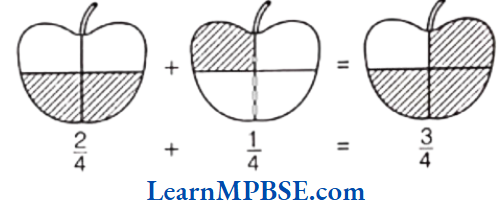
Hence, she gave \(\frac{3}{4}\) apple to both of us
Question 8. Mother asked Neelu and her brother to pick stones from the wheat. Neelu picked one-fourth of the total stones in it and her brother also picked up one-fourth of the stones. What fraction of the stones did both pick up together?
Solution. Neelu and her brother picked up \(\frac{1}{4}\) th of stones each from the wheat.
∴ Total stones picked up by both of them
= \(\frac{1}{4}+\frac{1}{4}=\frac{1+1}{4}=\frac{2}{4}=\frac{1}{2}\)
Hence, both together picked up \(\frac{1}{2}\) fraction of the stones.
Question 9. Sohan was putting covers on his notebooks. He put one-fourth of the covers on Monday. He put another one-fourth on Tuesday and the remaining on Wednesday. What fraction of the covers did he put on Wednesday?
Solution. Covers putting by Sohan on Monday = \(\frac{1}{4}\)
Covers putting by him on Tuesday = \(\frac{1}{4}\)
∴ Covers putting by him on Wednesday
= \(1-\frac{1}{4}-\frac{1}{4}=\frac{4}{4}-\frac{1}{4}-\frac{1}{4}\)
[∴ 1 and \(\frac{4}{4}\) are equivalent fractions]
= \(\frac{4-1-1}{4}=\frac{2}{4}=\frac{1}{2}\)
Hence, he put one-half of the covers on Wednesday.
Mp Board Maths Chapter 7 Solutions
Question 10. Add with the help of a diagram.
(1) \(\frac{1}{8}+\frac{1}{8}\)
(2) \(\frac{2}{5}+\frac{3}{5}\)
Solution.
(1) Here, draw two rectangles and divide them into 8 equal parts out of which 1 part is shaded. On adding them, we get 2 parts shaded out of 8 equal parts. Thus,

i.e. \(\frac{1}{8}+\frac{1}{8}=\frac{1+1}{8}=\frac{2}{8}=\frac{1}{4}\)
(2) Here, draw two rectangles and divide them into 5 equal parts separately. In first rectangle, 2 parts out of 5 parts are shaded and in second rectangle, 3 parts out of 5 parts are shaded. On adding them, we get all 5 parts shaded. Thus,

i.e. \(\frac{2}{5}+\frac{3}{5}=\frac{2+3}{5}=\frac{5}{5}=1\)
Question 11. Add \(\frac{1}{12}+\frac{1}{12}\). How will we show this pictorially? Using paper folding?
Solution. We have, \(\frac{1}{12}+\frac{1}{12}=\frac{1+1}{12}=\frac{2}{12}=\frac{1}{6}\)
Pictorially, it can be shown as
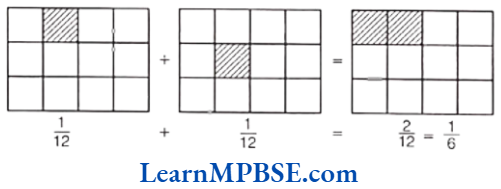
By folding paper, it can be shown in the following way Take a square piece of paper say ABCD.
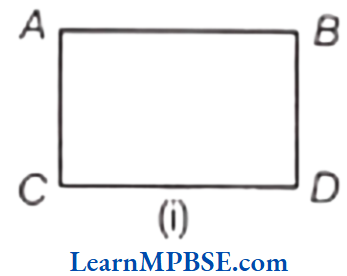
Fold it by overlapping its edge AB and CD to get a figure.
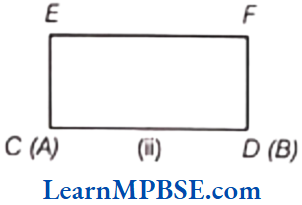
Again, refold it by taking EF over C(A) D(B) to get a figure.
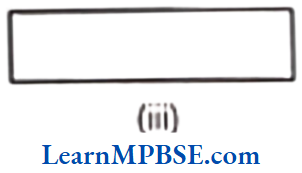
Now, reopen it, then we get the following figure
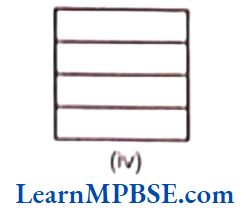
Now, fold it vertically at two places to obtain three equal vertical portion as shown in figure.
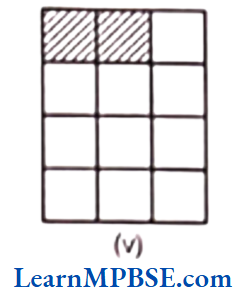
Shaded \(\frac{1}{12}\) portion twice,
We see that \(\frac{1}{12}+\frac{1}{12}=\frac{1+1}{12}=\frac{2}{12}=\frac{1}{6}\)
Question 12. Make 5 more examples of problems given in 1 and 2 above. Solve them with your friends.
Solution.
(1) \(\frac{1}{4}+\frac{1}{4}=\frac{1+1}{4}=\frac{2}{4}=\frac{1}{2}\)
[Since, denominator of both fractions are same. Thus, to add these we only add the numerators of both fractions and denominators remain same]
(2) \(\frac{3}{6}+\frac{7}{6}+\frac{1}{6}=\frac{3+7+1}{6}=\frac{11}{6}\)
[Since, denominator of both fractions are same. Thus, to add these we only add the numerators of both fractions and denominators remain same]
(3) \(\frac{5}{9}+\frac{8}{9}=\frac{5+8}{9}=\frac{13}{9}\)
[Since, denominator of both fractions are same. Thus, to add these we only add the numerators of both fractions and denominators remain same]
(4) \(\frac{1}{10}+\frac{9}{10}=\frac{1+9}{10}=\frac{10}{10}=1\)
[Since, denominator of both fractions are same. Thus, to add these we only add the numerators of both fractions and denominators remain same]
(5) \(\frac{11}{12}+\frac{4}{12}+\frac{5}{12}+\frac{6}{12}=\frac{11+4+5+6}{12}=\frac{26}{12}=\frac{13}{6}\)
[Since, denominator of both fractions are same. Thus, to add these we only add the numerators of both fractions and denominators remain same]
Mp Board Maths Chapter 7 Solutions
Question 13. Find the difference between \(\frac{7}{8}\) and \(\frac{3}{8}\).
Solution. Given, \(\frac{7}{8}\) and \(\frac{3}{8}\)
∴ Difference = \(\frac{7}{8}-\frac{3}{8}=\frac{7-3}{8}=\frac{4}{8}=\frac{1}{2}\)
Question 14. Mother made a gud patti in a round shape. She divided it into 5 parts. Seema ate one piece from it. If I eat another piece, then how much would be left?
Solution. Total number of equal parts of gud patti = 5
Gud patti eaten by Seema = \(\frac{1}{5}\); Gud patti eaten by me = \(\frac{1}{5}\)
Fraction of gud patti eaten by Seema and me
= \(\frac{1}{5}+\frac{1}{5}=\frac{1+1}{5}=\frac{2}{5}\)
∴ Fraction of gud patti left out = \(\frac{1}{1}-\frac{2}{5}=\frac{5-2}{5}=\frac{3}{5}\)
Hence, \(\frac{3}{5}\)th of the gud patti would be left.
Question 15. My elder sister divided the watermelon into 16 parts. I ate 7 out of them. My friend ate 4. How much did we eat between us? How much more of the watermelon did I eat than my friend? What portion of the watermelon remained?
Solution. Here, a watermelon is divided into 16 parts.
∴ Each part = \(\frac{1}{16}\)
I ate 7 parts out of 16 parts i.e. \(\frac{7}{16}\) part
My friend ate 4 parts out of 16 parts i.e. \(\frac{4}{16}\) part
Now, the part which we eat together
= \(\frac{7}{16}+\frac{4}{16}=\frac{7+4}{16}=\frac{11}{16} \text { part }\)
Now, difference between our parts = \(\frac{7}{16}-\frac{4}{16}=\frac{7-4}{16}=\frac{3}{16}\)
So, I ate \(\frac{3}{16}\) part of watermelon more than my friend.
Now, remaining part of the watermelon = \(1-\frac{11}{16}=\frac{16}{16}-\frac{11}{16}\)
[∴ \(\frac{16}{16}\) and 1 are equivalent fractions]
= \(\frac{16-11}{16}=\frac{5}{16}\)
Chapter 7 Fractions Exercise 7.5
Question 1. Write these fractions appropriately as additions or subtractions:
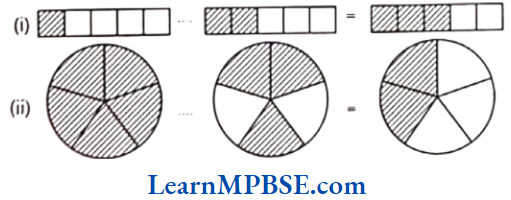
Solution. (1) In first figure, fraction for shaded portion = \(\frac{1}{5}\)
In second figure, fraction for shaded portion = \(\frac{2}{5}\)
and in third figure, fraction for shaded portion = \(\frac{3}{5}\)
Here, third figure represents more shaded portion than first and second figures.
So, \(\frac{1}{5}+\frac{2}{5}=\frac{1+2}{5}=\frac{3}{5}\)
∴ The given figure will be as follows

(2) In first figure, fraction for shaded portion = 1 or \(\frac{5}{5}\)
In second figure, fraction for shaded portion = \(\frac{3}{5}\)
and in third figure, fraction for shaded portion = \(\frac{2}{5}\)
Here, third figure represents less shaded portion than first and second figure.
So, \(1-\frac{3}{5}=\frac{5-3}{5}=\frac{2}{5}\)
∴ The given figure represented as follows
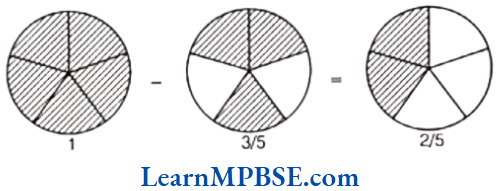
Question 2. Solve
1. \(\frac{1}{18}+\frac{1}{18}\)
2. \(\frac{8}{15}+\frac{3}{15}\)
3. \(\frac{7}{7}-\frac{5}{7}\)
4. \(\frac{1}{22}+\frac{21}{22}\)
5. \(\frac{12}{15}-\frac{7}{15}\)
6. \(\frac{5}{8}+\frac{3}{8}\)
7. \(1-\frac{2}{3}\)
8. \(\frac{1}{4}+\frac{0}{4}\)
9. \(3-\frac{12}{5}\)
Solution. (1) We have, \(\frac{1}{18}+\frac{1}{18}=\frac{1+1}{18}=\frac{2}{18}=\frac{1}{9}\) [simplest form]
(2) We have, \(\frac{8}{15}+\frac{3}{15}=\frac{8+3}{15}=\frac{11}{15}\) [simplest form]
(3) We have, \(\frac{7}{7}-\frac{5}{7}=\frac{7-5}{7}=\frac{2}{7}\) [simplest form]
(4) We have, \(\frac{1}{22}+\frac{21}{22}=\frac{1+21}{22}=\frac{22}{22}=1\) [simplest form]
(5) We have, \(\frac{12}{15}-\frac{7}{15}=\frac{12-7}{15}=\frac{5}{15}=\frac{1}{3}\) [simplest form]
(6) We have, \(\frac{5}{8}+\frac{3}{8}=\frac{5+3}{8}=\frac{8}{8}=1\) [simplest form]
(7) We have, \(1-\frac{2}{3}=\frac{3}{3}-\frac{2}{3}=\frac{3-2}{3}=\frac{1}{3}\)
[∴ 1 and \(\frac{3}{3}\) are (simplest form) equivalent fractions]
(8) We have, \(\frac{1}{4}+\frac{0}{4}=\frac{1+0}{4}=\frac{1}{4}\) [simplest form]
(9) We have, \(3-\frac{12}{5}=\frac{3}{1}-\frac{12}{5}=\frac{3 \times 5}{1 \times 5}-\frac{12}{5}\)
[converting \(\frac{3}{1}\) into like fraction by multiplying numerator and denominator by 5]
= \(\frac{15}{5}-\frac{12}{5}=\frac{15-12}{5}=\frac{3}{5}\) [simplest form]
Question 3. Shubham painted \(\frac{2}{3}\) of the wall space in his room. His sister Madhavi helped and painted \(\frac{1}{3}\) of the wall space. How much did they paint together?
Solution. Portion of the wall painted by Shubham = \(\frac{2}{3}\)
Portion of the wall painted by Madhavi = \(\frac{1}{3}\)
Portion of the wall painted by both = \(\frac{2}{3}+\frac{1}{3}=\frac{2+1}{3}=\frac{3}{3}=1\)
Hence, they painted complete wall together.
Mp Board Maths Chapter 7 Solutions
Question 4. Javed was given \(\frac{5}{7}\) of a basket of oranges. What fraction of oranges was left in the basket?
Solution. Let full basket = 1 = \(\frac{7}{7}\)
Part of oranges given to Javed = \(\frac{5}{7}\)
∴ Part of oranges left in the basket = \(\frac{7}{7}-\frac{5}{7}=\frac{7-5}{7}=\frac{2}{7}\)
Hence, \(\frac{2}{7}\) part of oranges was left in the basket.
Question 5. Add \(\frac{2}{5}\) and \(\frac{3}{7}\)
Solution. We have, \(\frac{2}{5}+\frac{3}{7}\)
LCM of 5 and 7 = 35
∴ \(\frac{2}{5}+\frac{3}{7}=\frac{2 \times 7}{5 \times 7}+\frac{3 \times 5}{7 \times 5}=\frac{14}{35}+\frac{15}{35}=\frac{14+15}{35}=\frac{29}{35}\)
Hence, \(\frac{2}{5}+\frac{3}{7}=\frac{29}{35}\)
Question 6. Subtract \(\frac{2}{5}\) from \(\frac{5}{7}\).
Solution. We have, \(\frac{5}{7}-\frac{2}{5}\)
LCM of 5 and 7 = 35
∴ \(\frac{5}{7}-\frac{2}{5}=\frac{5 \times 5}{7 \times 5}-\frac{2 \times 7}{5 \times 7}=\frac{25}{35}-\frac{14}{35}=\frac{25-14}{35}=\frac{11}{35}\)
Hence, \(\frac{5}{7}-\frac{2}{5}=\frac{11}{35}\)
Chapter 7 Fractions Exercise 7.6
Question 1. Solve
1. \(\frac{2}{3}\) + \(\frac{1}{7}\)
2. \(\frac{3}{10}\) + \(\frac{7}{15}\)
3. \(1 \frac{1}{3}+3 \frac{2}{3}\)
4. \(\frac{16}{5}-\frac{7}{5}\)
5. \(\frac{4}{3}-\frac{1}{2}\)
Solution. (1) We have, \(\frac{2}{3}\) + \(\frac{1}{7}\) (LCM of 3 and 7 = 21)
∴ \(\frac{2}{3}+\frac{1}{7}=\frac{2 \times 7}{3 \times 7}+\frac{1 \times 3}{7 \times 3}=\frac{14}{21}+\frac{3}{21}=\frac{14+3}{21}=\frac{17}{21}\)
Hence, \(\frac{2}{3}+\frac{1}{7}=\frac{17}{21}\)
(2) We have, \(\frac{3}{10}\) + \(\frac{7}{15}\) (LCM of 10 and 15 = 30)
∴ \(\frac{3}{10}+\frac{7}{15}=\frac{3 \times 3}{10 \times 3}+\frac{7 \times 2}{15 \times 2}=\frac{9}{30}+\frac{14}{30}=\frac{9+14}{30}=\frac{23}{30}\)
Hence, \(\frac{3}{10}+\frac{7}{15}=\frac{23}{30}\)
(3) We have, \(1 \frac{1}{3}+3 \frac{2}{3}\)
= \(1+\frac{1}{3}+3+\frac{2}{3}\)
= \((1+3)+\left(\frac{1}{3}+\frac{2}{3}\right)=4+\frac{1}{3}+\frac{2}{3}\)
Now, \(\frac{1}{3}+\frac{2}{3}=\frac{1+2}{3}=\frac{3}{3}=1\)
∴ \(4+\frac{1}{3}+\frac{2}{3}=4+1=5\)
Hence, \(1 \frac{1}{3}+3 \frac{2}{3}=5\)
(4) We have, \(\frac{16}{5}-\frac{7}{5}\)
∴ \(\frac{16}{5}-\frac{7}{5}=\frac{16-7}{5}=\frac{9}{5}\)
Hence, \(\frac{16}{5}-\frac{7}{5}=\frac{9}{5}\)
(5) We have, \(\frac{4}{3}-\frac{1}{2}\)
LCM of 3 and 2 = 6
∴ \(\frac{4}{3}-\frac{1}{2}=\frac{4 \times 2}{3 \times 2}-\frac{1 \times 3}{2 \times 3}=\frac{8}{6}-\frac{3}{6}=\frac{8-3}{6}=\frac{5}{6}\)
Hence, \(\frac{4}{3}-\frac{1}{2}=\frac{5}{6}\)
Mp Board Maths Chapter 7 Solutions
Question 2. Sarita bought \(\frac{2}{5}\) metre of ribbon and Lalita bought \(\frac{3}{4}\) metre of ribbon. What is the total length of the ribbon they bought?
Solution. Given, ribbon bought by Sarita = \(\frac{2}{5}\) m
and ribbon bought by Lalita = \(\frac{3}{4}\) m
∴ Total length of the ribbon bought buy them = \(\frac{2}{5}\) + \(\frac{3}{4}\)
Now, LCM of 5 and 4 = 20
∴ \(\frac{2}{5}+\frac{3}{4}=\frac{2 \times 4}{5 \times 4}+\frac{3 \times 5}{4 \times 5}=\frac{8}{20}+\frac{15}{20}=\frac{8+15}{20}=\frac{23}{20}\)
Hence, the total length of ribbon bought by them is \(\frac{23}{20}\) m.
Question 3. Naina was given \(1 \frac{1}{2}\) piece of cake and Najma was given \(1 \frac{1}{3}\) piece of cake. Find the total amount of cake was given to both of them.
Solution. Cake given to Naina = \(1 \frac{1}{2}\) piece
Cake given to Najma = \(1 \frac{1}{3}\) piece
Total cake given to both of them
\(=1 \frac{1}{2}+1 \frac{1}{3}=\frac{1 \times 2+1}{2}+\frac{1 \times 3+1}{3}=\frac{3}{2}+\frac{4}{3}\)LCM of 2 and 3 = 6
∴ \(\frac{3}{2}+\frac{4}{3}=\frac{3 \times 3}{2 \times 3}+\frac{4 \times 2}{3 \times 2}=\frac{9}{6}+\frac{8}{6}=\frac{9+8}{6}=\frac{17}{6}\)
Hence, the total cake given to both of them = \(\frac{17}{6}\) piece
Question 4. Complete the addition subtraction box.
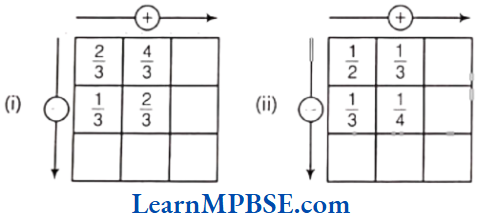
Solution. (1) Here, \(\frac{2}{3}+\frac{4}{3}=\frac{2+4}{3}=\frac{6}{3}=2 \text { and } \frac{1}{3}+\frac{2}{3}=\frac{1+2}{3}=\frac{3}{3}=1\)
Now, \(\frac{2}{3}-\frac{1}{3}=\frac{2-1}{3}=\frac{1}{3} \text { and } \frac{4}{3}-\frac{2}{3}=\frac{4-2}{3}=\frac{2}{3}\)
Also, we have 2 – 1 = 1 and \(\frac{1}{3}+\frac{2}{3}=\frac{1+2}{3}=\frac{3}{3}=1\)
Hence, the required complete box is
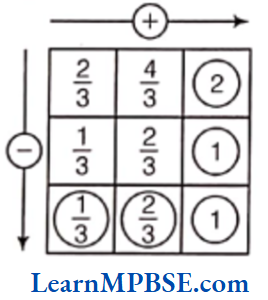
(2) Here, \(\frac{1}{2}+\frac{1}{3}=\frac{1 \times 3}{2 \times 3}+\frac{1 \times 2}{3 \times 2}=\frac{3}{6}+\frac{2}{6}=\frac{3+2}{6}=\frac{5}{6}\)
[∴ LCM of 2 and 3 = 6]
and \(\frac{1}{3}+\frac{1}{4}=\frac{1 \times 4}{3 \times 4}+\frac{1 \times 3}{4 \times 3}=\frac{4}{12}+\frac{3}{12}\)
= \(\frac{4+3}{12}=\frac{7}{12}\) [∴ LCM of 3 and 4 = 12]
Now, \(\frac{1}{2}-\frac{1}{3}=\frac{1 \times 3}{2 \times 3}-\frac{1 \times 2}{3 \times 2}\)
= \(\frac{3}{6}-\frac{2}{6}=\frac{3-2}{6}=\frac{1}{6}\)
[∴ LCM of 2 and 3 = 6]
and \(\frac{1}{3}-\frac{1}{4}=\frac{1 \times 4}{3 \times 4}-\frac{1 \times 3}{4 \times 3}\)
= \(\frac{4}{12}-\frac{3}{12}=\frac{4-3}{12}=\frac{1}{12}\)
[∴ LCM of 3 and 4 = 12]
Also, we have \(\frac{5}{6}-\frac{7}{12}=\frac{5 \times 2}{6 \times 2}-\frac{7 \times 1}{12 \times 1}\)
[∴ LCM of 6 and 12 = 12]
= \(\frac{10}{12}-\frac{7}{12}=\frac{10-7}{12}=\frac{3}{12}=\frac{1}{4}\)
[dividing numerator and denominator by 3]
and \(\frac{1}{6}+\frac{1}{12}=\frac{1 \times 2}{6 \times 2}+\frac{1 \times 1}{12 \times 1}\)
= \(\frac{2}{12}+\frac{1}{12}=\frac{2+1}{12}=\frac{3}{12}=\frac{1}{4}\)
[∴ LCM of 6 and 12 = 12]
[dividing numerator and denominator by 3]
Hence, the required complete box is
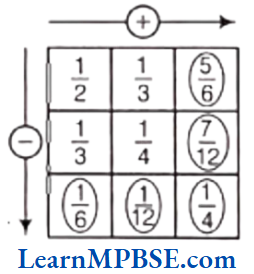
Question 5. A piece of wire \(\frac{7}{8}\) meter long broke into two pieces. One piece was \(\frac{1}{4}\) metre long. How long is the other piece?
Solution. Given, total length of a piece of wire = \(\frac{7}{8}\) m
Length of one piece of wire = \(\frac{1}{4}\) m
∴ Length of another piece = \(\left(\frac{7}{8}-\frac{1}{4}\right) \mathrm{m}\)
LCM of 8 and 4 = 8
∴ \(\frac{7}{8}-\frac{1}{4}=\frac{7 \times 1}{8 \times 1}-\frac{1 \times 2}{4 \times 2}\)
= \(\frac{7}{8}-\frac{2}{8}=\frac{7-2}{8}=\frac{5}{8}\)
Hence, the length of another piece of wire is \(\frac{5}{8}\) m.
Class 6 Mp Board Maths Question Answers
Question 6. Nandini’s house is \(\frac{9}{10}\) km from her school. She walked some distance and then took a bus for \(\frac{1}{2}\)km to reach the school. How far did she walk?
Solution. Given, distance of school from Nandini’s house = \(\frac{9}{10}\) km
Distance covered by Nandini by bus = \(\frac{1}{2}\) km
∴ Distance covered by Nandini by walking = \(\frac{9}{10}\) – \(\frac{1}{2}\)
LCM of 10 and 2 = 10
\(\frac{9}{10}-\frac{1}{2}=\frac{9 \times 1}{10 \times 1}-\frac{1 \times 5}{2 \times 5}=\frac{9}{10}-\frac{5}{10}\)= \(\frac{9-5}{10}=\frac{4}{10}=\frac{2}{5} \mathrm{~km}\)
Hence, she walked \(\frac{2}{5}\) km.
Question 7. Asha and Samuel have bookshelves of the same size partly filled with books. Asha’s shelf is \(\frac{5}{6}\)th full and Samuel’s shelf is \(\frac{2}{5}\)th full. Whose bookshelf is more full ? By what fraction?
Solution. The protion of Asha’s shelf filled by books = \(\frac{5}{6}\) part
and the portion of Samuel’s shelf filled by books = \(\frac{2}{5}\) part
Now, LCM of 6 and 5 = 30
Equivalent fractions of \(\frac{5}{6}\) are \(\frac{5 \times 2}{6 \times 2}, \frac{5 \times 3}{6 \times 3}, \frac{5 \times 4}{6 \times 4}, \frac{5 \times 5}{6 \times 5}, \ldots\)
i.e. \(\frac{10}{12}, \frac{15}{18}, \frac{20}{24}, \frac{25}{30}, \ldots\)
and equivalent fractions of \(\frac{2}{5}\) are
\(\frac{2 \times 2}{5 \times 2}, \frac{2 \times 3}{5 \times 3}, \frac{2 \times 4}{5 \times 4}, \frac{2 \times 5}{5 \times 5}, \frac{2 \times 6}{5 \times 6}, \ldots\)i.e. \(\frac{4}{10}, \frac{6}{15}, \frac{8}{20}, \frac{10}{25}, \frac{12}{30}, \ldots\)
Here, equivalent fractions \(\frac{12}{30}\) and \(\frac{25}{30}\) have same denominator.
∴ 25 > 12
∴ \(\frac{25}{30}>\frac{12}{30} \text { i.e. } \frac{5}{6}>\frac{2}{5}\)
Now, \(\frac{5}{6}-\frac{2}{5}=\frac{25}{30}-\frac{12}{30}=\frac{25-12}{30}=\frac{13}{30}\)
Hence, Asha’s book shelf is more full by fraction \(\frac{13}{30}\).
Question 8. Jaidev takes \(2 \frac{1}{5}\) minutes to walk across the school ground. Rahul takes \(\frac{7}{4}\) minutes to do the same. Who takes less time and by what fraction?
Solution. Time taken by Jaidev to walk across the school ground = \(2 \frac{1}{5} \min =\frac{11}{5} \min\)
and time taken by Rahul to walk across the school ground = \(\frac{7}{4}\) min
Now, equivalent fractions of \(\frac{11}{5}\) are
\(\frac{11 \times 2}{5 \times 2}, \frac{11 \times 3}{5 \times 3}, \frac{11 \times 4}{5 \times 4}, \frac{11 \times 5}{5 \times 5}, \ldots \text { i.e. } \frac{22}{10}, \frac{33}{15}, \frac{44}{20}, \frac{55}{25}, \ldots\)and equivalent fractions of \(\frac{7}{4} are \frac{7 \times 2}{4 \times 2}, \frac{7 \times 3}{4 \times 3}, \frac{7 \times 4}{4 \times 4}, \frac{7 \times 5}{4 \times 5},\)
i.e. \(\frac{14}{8}, \frac{21}{12}, \frac{28}{16}, \frac{35}{20}, \ldots\)
Here, equivalent fractions \(\frac{44}{20}\) and \(\frac{35}{20}\) have same denominators.
∴ 44 > 35
∴ \(\frac{44}{20}>\frac{35}{20} \text { i.e. } \frac{11}{5}>\frac{7}{4}\)
Now, \(\frac{11}{5}-\frac{7}{4}=\frac{44}{20}-\frac{35}{20}=\frac{44-35}{20}=\frac{9}{20}\)
Hence, Rahul takes less time by \(\frac{9}{20}\) min.
Chapter 7 Fractions Multiple Choice Questions
Question 1. The two consecutive integers between which the fraction \(\frac{5}{7}\) lies are
- 5 and 6
- 0 and 1
- 5 and 7
- 6 and 7
Answer. 2. 0 and 1
Question 2. How is the fractional number of “3 out of 7 of the fruits are apples” written ?
- \(\frac{3}{7}\)
- \(\frac{7}{3}\)
- \(\frac{4}{7}\)
- \(\frac{4}{3}\)
Answer. 1. \(\frac{3}{7}\)
Class 6 Mp Board Maths Question Answers
Question 3. \(\frac{21}{19}\) can be expressed in form
- \(2 \frac{3}{19}\)
- \(2 \frac{1}{19}\)
- \(1 \frac{2}{19}\)
- \(3 \frac{1}{19}\)
Answer. 3. \(1 \frac{1}{19}\)
Question 4. Raju scored 9 m arks in maths test. If the maximum marks of the test is 25, how is Raju’s score represented as a fraction?
- \(\frac{1}{25}\)
- \(\frac{16}{25}\)
- \(\frac{9}{25}\)
- \(\frac{25}{25}\)
Answer. 3. \(\frac{9}{25}\)
Question 5. The fraction which is not equal to \(\frac{4}{5}\) is
- \(\frac{40}{50}\)
- \(\frac{12}{15}\)
- \(\frac{16}{20}\)
- \(\frac{9}{15}\)
Answer. 4. \(\frac{9}{15}\)
Question 6. If \(\frac{3}{4}\) is equivalent to \(\frac{x}{24}\), then the value of x is
- 15
- 20
- 16
- 18
Answer. 4. 18
Question 7. Which option given an equivalent fraction of \(\frac{13}{25}\) ?
- \(\frac{65}{50}\)
- \(\frac{26}{75}\)
- \(\frac{156}{300}\)
- \(\frac{103}{205}\)
Answer. 3. \(\frac{156}{300}\)
Question 8. When \(\frac{1}{4}\) is written with denominator as 12, its numerator is
- 3
- 8
- 24
- 12
Answer. 1. 3
Class 6 Mp Board Maths Question Answers
Question 9. When \(\frac{1}{7}\) is written with denominator as 56, its numerator is
- 3
- 8
- 24
- 12
Answer. 2. 8
Question 10. Which of the following is not in the lowest form?
- \(\frac{7}{5}\)
- \(\frac{15}{20}\)
- \(\frac{13}{33}\)
- \(\frac{27}{28}\)
Answer. 2. \(\frac{15}{20}\)
Question 11. Which of the following fraction is smallest?
- \(\frac{16}{23}\)
- \(\frac{17}{23}\)
- \(\frac{9}{23}\)
- \(\frac{11}{23}\)
Answer. 3. \(\frac{9}{23}\)
Question 12. If \(\frac{5}{8}\) = \(\frac{20}{p}\), then value of p is
- 23
- 2
- 32
- 16
Answer. 3. 32
Question 13. If \(\frac{7}{9}\) = \(\frac{28}{p}\), then value of p is
- 23
- 2
- 36
- 16
Answer. 3. 36
Question 14. What are the fractions with the same denominator called?
- Unit fractions
- Unlike fractions
- Like fractions
- Improper fractions
Answer. 3. Like fractions
Question 15. The ascending order of the fractions \(\frac{14}{17}, \frac{10}{12}, \frac{6}{7}\) and \(\frac{18}{22}\) is
- \(\frac{6}{7}, \frac{14}{17}, \frac{10}{12}, \frac{18}{22}\)
- \(\frac{18}{22}, \frac{14}{17}, \frac{10}{12}, \frac{6}{7}\)
- \(\frac{14}{17}, \frac{10}{12}, \frac{14}{17}, \frac{18}{22}\)
- \(\frac{6}{7}, \frac{10}{12}, \frac{14}{17}, \frac{18}{22}\)
Answer. 2. \(\frac{18}{22}, \frac{14}{17}, \frac{10}{12}, \frac{6}{7}\)
Question 16. Sum of \(\frac{4}{17}\) and \(\frac{15}{17}\) is
- \(2 \frac{1}{17}\)
- \(1 \frac{2}{17}\)
- \(3 \frac{1}{17}\)
- \(3 \frac{2}{17}\)
Answer. 2. \(1 \frac{2}{17}\)
Question 17. On subtracting \(\frac{6}{13}\) from \(\frac{11}{13}\), the result is
- \(\frac{5}{13}\)
- \(\frac{2}{13}\)
- \(\frac{3}{13}\)
- \(\frac{8}{13}\)
Answer. 1. \(\frac{5}{13}\)
Class 6 Mp Board Maths Question Answers
Question 18. What should be added to \(\frac{11}{17}\) to make it \(\frac{15}{17}\) ?
- \(\frac{26}{17}\)
- 4
- \(\frac{4}{17}\)
- \(\frac{4}{34}\)
Answer. 3. \(\frac{4}{17}\)
Question 19. Choose the correct option for the sum of shaded parts of the given boxes.

- \(\frac{2}{5}+\frac{2}{5}=\frac{4}{5}\)
- \(\frac{2}{5}+\frac{1}{5}=\frac{3}{5}\)
- \(\frac{2}{5}-\frac{1}{5}=\frac{1}{5}\)
- \(\frac{3}{5}+\frac{1}{5}=\frac{4}{5}\)
Answer. 2. \(\frac{2}{5}+\frac{1}{5}=\frac{3}{5}\)
Chapter 7 Fractions Assertion – Reason
Question 1. Assertion (A) \(\frac{2}{7}\) is obtained when we divide a whole into seven equal parts and take two part.
Reason (R) A fraction is a number representing part of a whole.
(a) Both A and R are true and R is the correct explanation of A.
(b) Both A and R are true and R is not the correct explanation of A.
(c) A is true but R is false.
(d) A is false but R is true.
Answer. (a) Both A and R are true and R is the correct explanation of A.
Question 2. Assertion (A) The simplest form of \(\frac{12}{20}\) is \(\frac{3}{5}\)
Reason (R) A fraction is said to be in the simplest (or lowest) form if its numerator and denominator have no common factor except 1.
(a) Both A and R are true and R is the correct explanation of A.
(b) Both A and R are true and R is not the correct explanation of A.
(c) A is true but R is false.
(d) A is false but R is true.
Answer. (a) Both A and R are true and R is the correct explanation of A.
Question 3. Assertion (A) \(\frac{4}{5}\) > \(\frac{6}{5}\)
Reason (R) For two fract ions with the same denominator, the fraction with greater numerator is greater.
(a) Both A and R are true and R is the correct explanation of A.
(b) Both A and R are true and R is not the correct explanation of A.
(c) A is true but R is false.
(d) A is false but R is true.
Answer. (d) A is false but R is true.
Chapter 7 Fractions Fill in the Blanks
Question 1. A number representing a part of a ….. is called a fraction.
Answer. Whole
Question 2. 1 whole = …. tenths.
Answer. 10
Question 3. A fraction with numerator greater than the denominator is called an ….. fraction.
Answer. Improper
Question 4. \(\frac{21}{13}\) is an ….. fraction.
Answer. Improper
Question 5. \(13 \frac{5}{18}\) is a …… fraction.
Answer. Mixed
Mp Board Class 6 Book Solutions
Chapter 7 Fractions True/False
Question 1. If a whole of an object is divided into a number of equal parts, then each parts, then each part represents a fraction.
Answer. True
Question 2. The fraction represented by the shaded portion in the following figure is \(\frac{3}{8}\).
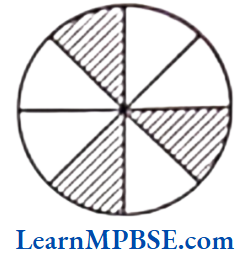
Answer. True
Question 3. The fraction represented by the unshaded portion in the following figure is \(\frac{5}{9}\).
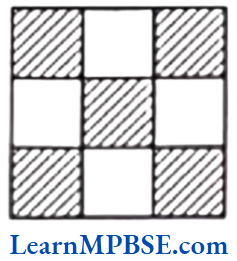
Answer. False
Question 4. Ali divided one fruit cake equally among six persons. The part of the cake he gave to each person is \(\frac{1}{6}\).
Answer. True
Question 5. Sum of \(\frac{5}{12}\) and \(\frac{7}{12}\) is \(1 \frac{7}{12}\)
Answer. False
Chapter 7 Fractions Match the Columns
Question 1.
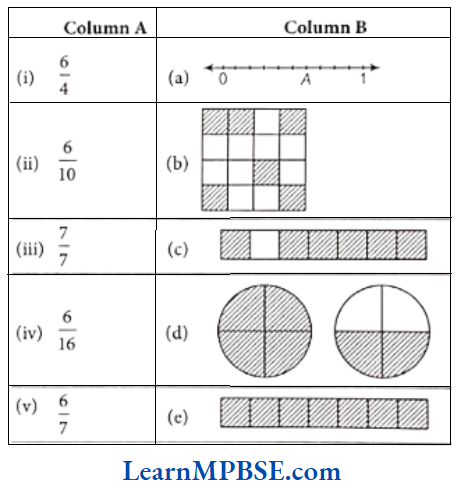
Solution. (i) → (d), (ii) → (a), (iii) → (e), (iv) → (b), (v) → (c)
Question 2.
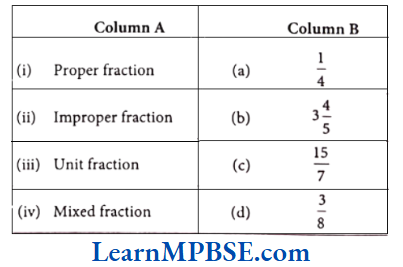
Solution. (i) → (d), (ii) → (c), (iii) → (a), (iv) → (b)
Question 3.
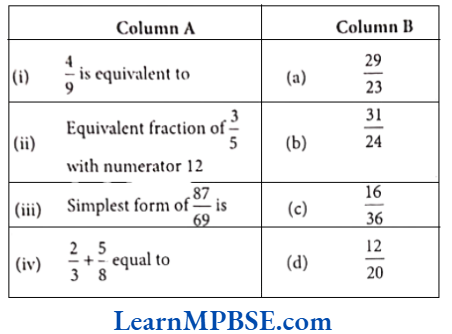
Solution. (i) → (c), (ii) → (d), (iii) → (a), (iv) → (b)
Chapter 7 Fractions Case Based Questions
Question 1. Cross country is a running even in which runners completed a pre-decided distance.
It includes different activities in which runners cover different environments. A cross country running event of 11 km is as follows.
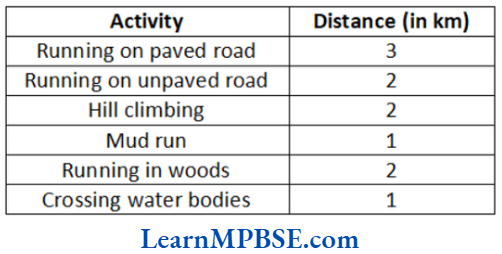
(1) What fraction of the total distance is the mud run?
(a) \(\frac{11}{1}\)
(b) \(\frac{1}{10}\)
(c) \(\frac{1}{11}\)
(d) 1
(2) What fraction of the total distance is the distance covered on paved and unpaved roads?
(a) \(\frac{3}{2}\)
(b) \(\frac{5}{5}\)
(c) \(\frac{5}{6}\)
(d) \(\frac{5}{11}\)
Solution. (1) (c) Total distance runner covers = 11km
Distance in mud run = 1 km
∴ Fraction of total distance in mud run \(=\frac{\text { Distance in mud run }}{\text { Total distance runner covers }}=\frac{1}{11}\)
(2) (d) Distance in paved road = 3 km.
Distance in unpaved road = 2 km.
∴ Total distance in both = \(\frac{3+2}{11}=\frac{5}{11}\)
Question 2. Katherine completed the cross country in 1 hr. She completed the run on the paved and unpaved roads in one-fourth of an hour while Juliana covered it in half an hour.
(1) In how many minutes did Katherine cover the distance on the paved and unpaved roads?
(a) 10 min
(b) 15 min
(c) 20 min
(d) 30 min
(2) How much more time (in hrs) was taken by Juliana than Katherine?
Solution. (1) (b) Katherine completed the cross country = 1hr
∴ Katherine covered the run on the paved and unpaved roads in one-fourth of an hour, which is equal to
\(\frac{1}{4} \times 1 \mathrm{~h}=\frac{1}{4} \times 60 \mathrm{~min}=15 \mathrm{~min}\)Thus, Katherine coveres the distance on paved and unpaved roads in 15 min.
(2) Katherine completed the run on the paved and unpaved road = \(\frac{1}{4}\) of 1 h = \(\frac{1}{4}\) x 60 min = 15 min
While Juliana covered the run on the paved and unpaved road = \(\frac{1}{2}\) of 1 h = \(\frac{1}{2}\) x 60 min = 30 min
Thus, Juliana time – Katherine time
= (30 – 15) = 15 min
Thus, Juliana takes 15 min or \(\frac{1}{4}\) of an hour more than Katherine.
Question 3. Parul and two of her friends share a pizza equally among themselves.
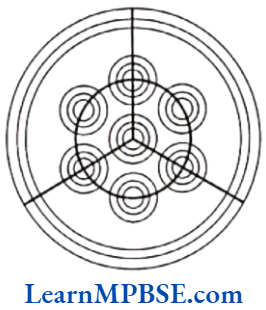
(1) Parul says, ‘Here are three equal halves of the pizza.’ Is parul’s statement correct? Give reasons.
(2) Which fraction represents one part of the whole pizza?
(a) \(\frac{1}{2}\)
(b) \(\frac{1}{3}\)
(c) \(\frac{2}{3}\)
(d) 3
Later, three more friends join Parul. Parul divides the pizza again to have 6 parts.
(3) Does every one get an equal portion? Give reasons.
(4) Suggest a way to divide the pizza into six equal parts.
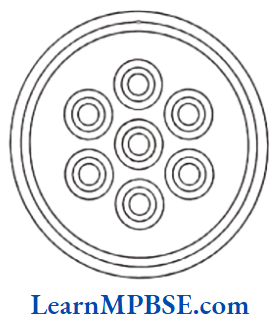
Solution. (1) No, Parul’s statement is not correct. Pizza is divided into three equal parts, which is not half of the pizza.
(2) (b) Pizza divided into 3 parts.
Therefore, one part of pizza = \(\frac{1}{3}\).
(3) Three more friends joined Parul means now remaining pizza is divided again.
So, everyone does not get an equal portion of pizza.
(4) Usually pizzas are circular. Therefore, total angle = 360°
To divide 360 into 6 parts divide 360 by 6
i.e. \(\frac{360^{\circ}}{6}=60^{\circ}\)
Now, measure 60° and cut the pizza into 6 equal parts.
Chapter 7 Fractions Very Short Answer Type Questions
Question 1. 3 mm is what fraction of a metre?
Solution. We know that 1 m = 1000 mm
3 mm = \(\frac{3}{1000}\) made
So, 3 mm is \(\frac{3}{1000}\) of a metre.
Question 2. Write \(\frac{2}{3}\) of 60 kg.
Solution. We have, \(\frac{2}{3}\) of 60 kg = \(\frac{2 \times 60}{3}=2 \times 20=40 \mathrm{~kg}\)
Question 3. What fraction of the week is 3 days?
Solution. We know that 1 week = 7 days 3
∴ 3 days = \(\frac{3}{7}\) week
So, 3 days are of a week.
Question 4. 30 seconds is what fraction of a minute?
Solution. We know that 1 min = 60 s
i.e. 60 s = 1 min
\(30 \mathrm{~s}=\frac{30}{60} \mathrm{~min}=\frac{1}{2} \mathrm{~min}\)So, 30 sec are \(\frac{1}{2}\) of a minute.
Question 5. Name the fraction which are always less than 1.
Solution. We know that proper fractions are always less than 1.
Chapter 7 Fractions Short Answer Type Questions
Question 1. Write the natural numbers from 205 to 219. What fraction of them are odd numbers?
Solution. Natural numbers from 205 to 219 are 205, 206, 207, 208, 209, 210, 211, 212, 213, 214, 215, 216, 217, 218, 219.
Total natural numbers = 15
Odd numbers = 8
∴ Required fraction = \(\frac{\text { Odd numbers }}{\text { Natural numbers }}=\frac{8}{15}\)
Question 2. What fraction of a kg is 650 gm?
Solution. We know that 1 kg = 1000 g
∴ \(650 \mathrm{gm}=\frac{650}{1000} \mathrm{~kg}=\frac{65}{100}\)
= \(\frac{65 \div 5}{100 \div 5}\) [∴ HCF of 65 and 100 is 5]
= \(\frac{13}{20}\)
So, 650 gm is \(\frac{13}{20}\) of a kg.
Question 3. Find the fraction that represents the number of natural numbers to total numbers of natural numbers to total numbers in the collection 0, 1, 2, 3, 4, 5. What fraction will it be for whole numbers?
Solution. Given collection is 0, 1, 2, 3, 4, 5.
Natural numbers = 1, 2, 3, 4, 5
∴ The fraction of natural numbers to the collection = \(\frac{5}{6}\)
Now, whole numbers = 0, 1, 2, 3, 4, 5
The fraction of whole numbers to the collection = \(\frac{6}{6}\) i.e. \(\frac{1}{1}\)
Question 4. Express the following as improper fraction.
(1) \(5 \frac{1}{4}\)
(2) \(7 \frac{2}{3}\)
Solution. (1) We have, \(5 \frac{1}{4}\)
Now, \(5 \frac{1}{4}=5+\frac{1}{4}=\frac{5 \times 4+1}{4}=\frac{21}{4}\)
(2) We have, \(7 \frac{2}{3}=7+\frac{2}{3}=\frac{7 \times 3+2}{3}=\frac{23}{3}\)
Question 5. Express the following as mixed fractions.
(1) \(\frac{15}{4}\)
(2) \(\frac{25}{6}\)
Solution. (1) We have, improper fraction = \(\frac{15}{4}\)
∴ \(\frac{15}{4}=3 \frac{3}{4}\)
(2) We have, improper fraction = \(\frac{25}{6}\)
∴ \(\frac{25}{6}=4 \frac{1}{6}\)
Question 6. Check whether the given fractions are equivalent.
(1) \(\frac{5}{7}\), \(\frac{9}{12}\)
(2) \(\frac{7}{5}\), \(\frac{21}{15}\)
Solution.
(1) We have, \(\frac{5}{7}\), \(\frac{9}{12}\) = \(\frac{5}{7}\) = \(\frac{9}{12}\)
⇒ 5 x 12 = 9 x 7
60 ≠ 63
So, \(\frac{5}{7}\), \(\frac{9}{12}\) are not equivalent fractions.
(2) We have, \(\frac{7}{5}\), \(\frac{21}{15}\) = \(\frac{7}{5}\) = \(\frac{21}{15}\)
⇒ 7 x 15 = 105, 21 x 5 = 105
So, \(\frac{7}{5}\), \(\frac{21}{15}\) are equivalent fractions.
Question 7. Write \(\frac{156}{60}\) in its lowest form.
Solution. We have, \(\frac{156}{60}\)
Now, we find the HCF of 156 and 60.
∴ HCF of 156 and 60 is 12.
So, \(\frac{156}{60}=\frac{156 \div 12}{60 \div 12}=\frac{13}{5}\)
Mp Board Class 6 Book Solutions
Question 8. Compare \(4 \frac{2}{3} \text { and } 5 \frac{3}{7}\).
Solution. We have, \(4 \frac{2}{3} \text { and } 5 \frac{3}{7}\)
Now, \(4 \frac{2}{3}=\frac{4 \times 3+2}{3}=\frac{14}{3} \text { and } 5 \frac{3}{7}=\frac{5 \times 7+3}{7}=\frac{38}{7}\)
Now, let us compare \(\frac{14}{3}\) and \(\frac{38}{7}\) by cross-multiplication.
We have, \(\frac{14}{3}\) = \(\frac{38}{7}\)
14 x 7 = 98 and 38 x 3 = 114
∴ 114 > 98
∴ \(\frac{38}{7}\) > \(\frac{14}{3}\)
So, \(5 \frac{3}{7}>4 \frac{2}{3}\)
Question 9. Find the value of the following:
(1) \(\frac{6}{17}+\frac{3}{17}+\frac{11}{17}\)
(2) \(\frac{1}{2}+\frac{3}{4}+1 \frac{1}{3}\)
Solution.
(1) We have, \(\frac{6}{17}+\frac{3}{17}+\frac{11}{17}=\frac{6+3+11}{17}=\frac{20}{17}=1 \frac{3}{17}\)
(2) We have, \(\frac{1}{2}+\frac{3}{4}+1 \frac{1}{3}=\frac{1}{2}+\frac{3}{4}+\frac{4}{3}=\frac{6+9+16}{12}\)
[∴ LCM of 2, 4 and 3 is 12]
= \(\frac{31}{12}=2 \frac{7}{12}\)
Question 10. Neelam’s father needs \(1 \frac{3}{4}\) m of cloth for the skirt of Neelam’s new dress and \(\frac{1}{2}\) m for the scarf. How much cloth must he buy in all?
Solution. Cloth required for skirt = \(1 \frac{3}{4}\) m
Cloth required for scarf = \(\frac{1}{2}\) m
∴ Total cloth = \(\left(1 \frac{3}{4}+\frac{1}{2}\right) \mathrm{m}=\frac{7}{4}+\frac{1}{2}\)
\(\frac{7+2}{4}=\frac{9}{4}=2 \frac{1}{4} \mathrm{~m}\) [∴ LCM of 2 and 4 is 4]
So, he must buy \(2 \frac{1}{4}\) m cloth.
Question 11. Sunil purchased \(12 \frac{1}{2}\) L of juice on Monday and \(14 \frac{3}{4}\) L of lace for her new dress. How much lace is left with her?
Solution. Sunil purchased juice on Monday = \(12 \frac{1}{2}\) L
Juice purchased on Tuesday = \(14 \frac{3}{4}\) L
∴ Total juice purchased = \(12 \frac{1}{2}+14 \frac{3}{4}=\frac{25}{2}+\frac{59}{4}\)
= \(\frac{50+59}{4}=\frac{109}{4}=27 \frac{1}{4} \mathrm{~L}\)
So, he purchased \(27 \frac{1}{4}\) L of juice in two days.
Question 12. Simplify the following:
(1) \(6-\frac{3}{4}\)
(2) \(\frac{7}{12}-\frac{4}{15}\)
Solution. (1) We have, \(6-\frac{3}{4}=\frac{6}{1}-\frac{3}{4}=\frac{24-3}{4}=\frac{21}{4}=5 \frac{1}{4}\)
(2) We have, \(\frac{7}{12}-\frac{4}{15}=\frac{35-16}{60}=\frac{19}{60}\)
Question 13. A cup is \(\frac{1}{3}\) full of milk. What part of the cup is still to be filled by milk to make it full?
Solution. Given, cup is \(\frac{1}{3}\) full of milk.
∴ Required milk = \(1-\frac{1}{3}=\frac{3-1}{3}=\frac{2}{3}\)
Hence, \(\frac{2}{3}\) part of the cup is required to make it full.
Question 14. May bought \(3 \frac{1}{2} \mathrm{~m}\) of lace. She used \(1 \frac{3}{4} \mathrm{~m}\) of lace
Solution. Mary bought lace = \(3 \frac{1}{2} \mathrm{~m}\)
Lace used for new dress = \(1 \frac{3}{4} \mathrm{~m}\)
∴ Lace left with her = \(3 \frac{1}{2}-1 \frac{3}{4}=\frac{7}{2}-\frac{7}{4}=\frac{14-7}{4}=\frac{7}{4}=1 \frac{3}{4} m\)
So, \(1 \frac{3}{4} \mathrm{~m}\) lace is left with her.
Question 15. Nazima gave \(2 \frac{3}{4}\) L out of the \(5 \frac{1}{2} \mathrm{~L}\) of juice she purchased to her friends. How many litres of juice is left with her?
Solution. Quantity of juice Nazima has = \(5 \frac{1}{2} \mathrm{~L}\)
She gave \(2 \frac{3}{4}\) L out of this to her friends.
Now, juice left with her = \(5 \frac{1}{2}-2 \frac{3}{4}=\frac{11}{2}-\frac{11}{4}\)
= \(\frac{22-11}{4}=\frac{11}{4}=2 \frac{3}{4} \mathrm{~L}\)
So, \(2 \frac{3}{4} \mathrm{~L}\) of juice is left with her.
Chapter 7 Fractions Long Answer Type Questions
Question 1. It was estimated that because of people switching to Metro trains, about 33000 tonne of CNG, 3300 tonne of diesel and 21000 tonne of petrol was saved by the end of year 2007.
Find the fraction of
(1) the quantity of diesel saved to the quantity of petrol saved.
(2) the quantity of diesel saved to the quantity of CNG saved.
Solution. Given, quantity of CNG saved = 33000 tonne
Quantity of diesel saved = 3300 tonne
Quantity of petrol saved = 21000 tonne
(1) The fraction of the quantity of diesel saved to the quantity of petrol saved=
= \(\frac{3300}{21000}=\frac{33}{210}=\frac{33 \div 3}{210 \div 3}\)
[∴ HCF of 33 and 210 is 3]
= \(\frac{11}{70}\)
(2) The fraction of the quantity of diesel to the quantity of CNG saved
= \(\frac{3300}{33000}=\frac{33}{330}=\frac{33+33}{330+33}=\frac{1}{10}\)
Question 2. Poorvi cut a cake into 8 equal pieces. If she wanted to divide each of them into 3 equal pieces, what fraction of the whole cake would each small pieces be?
Solution. Number of pieces in which the cake cut = 8
Number of pieces each cut piece divided into = 3
∴ Total number of pieces = 8 x 3 = 24
Hence, each piece is represented by the fraction \(\frac{1}{24}\)
Question 3. The energy content of different foods are as follows:
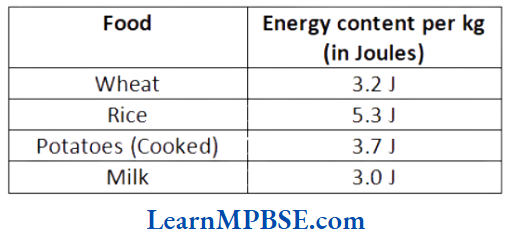
Which food provides the least energy and which provides the maximum? Also, express the least energy as a fraction of the maximum energy.
Solution. In the given table, we see that the minimum value is 3.0J and maximum value is 5.3 J.
∴ Least energy provide by food = 3.0J i.e. Milk
Food which provide the maximum energy = 5.3J i.e. Rice Least energy 30 30
∴ Required fraction \(=\frac{\text { Least energy }}{\text { Maximum energy }}=\frac{3.0}{5.3}=\frac{30}{53}\)
Question 4. A rectangle is divided into certain number of equal parts. If 16 of the parts so formed represent the fraction \(\frac{1}{4}\), find the number of parts in which the rectangle has been divided.
Solution. Let a rectangle be divided into x equal parts.
Now, 16 of the parts represent \(\frac{1}{4}\)
∴ \(\frac{16}{x}=\frac{1}{4}\) ⇒ x = 16 x 4 ⇒ x = 64 parts
Hence, rectangle is divided into 64 equal parts.
Question 5. From school X out of 750 students, 250 were selected for an essay writing and from another school Y out of 1200 students, 300 were selected. From which school, more students were selected?
Solution. Total students in school X = 750
Selected students = 250
∴ Fraction of selected students to the total students
= \(\frac{250}{750}=\frac{1}{3}\) …(1)
Now, total students in school Y = 1200
Selected students = 300
∴ Fraction of selected students to the total students
= \(\frac{300}{1200}=\frac{1}{4}\) …(2)
From Eqs. (1) and (2), \(\frac{1}{3}\) > \(\frac{1}{4}\) [∴ 4 > 3]
Hence, from the school X more students were selected.
Question 6. The fish caught bu Neetu was of weight \(3 \frac{3}{4}\) kg and the fish caught by Narendra was of weight \(2 \frac{1}{2}\) kg. How much more was Neetu’s fish weight than that of Narendra?
Solution. Given, weight of fish caught by Neetu = \(3 \frac{3}{4} \mathrm{~kg}=\frac{15}{4} \mathrm{~kg}\)
and weight of the fish caught by Narendra = \(2 \frac{1}{2}=\frac{5}{2} \mathrm{~kg}\)
∴ Difference between their weights
= \(\frac{15}{4}-\frac{5}{2}=\frac{15}{4}-\frac{5 \times 2}{2 \times 2}\)
= \(\frac{15}{4}-\frac{10}{4}=\frac{15-10}{4}=\frac{5}{4} \mathrm{~kg}\)
Hence, Neetu’s fish weight is kg more than the Narendra’s fish weight.
Question 7. On an average, \(\frac{1}{10}\) of the food eaten is turned into organism’s own body and is available for the next level of consumer in a food chain. What fraction of the food eaten is not available for the next level?
Solution. Quantity of food eaten which turned into organism’s own body = \(\frac{1}{10}\) of the total food
Now, the quantity of food eaten which is not available
for the next level = \(1-\frac{1}{10}=\frac{10-1}{10}=\frac{9}{10}\)
Hence, the required fraction = \(\frac{9}{10}\)
Question 8. Mr. Rajan got a job at the age of 24 yr and he got retired from the job at the age of 60 yr. What fraction of his age till retirement was he in the job?
Solution. Given, Rajan’s age on the joining = 24 yr and retirement age = 60 yr
The number of years, he did the job
= Retirement age – Joining age
= 60 – 24 = 36 yr
∴ The fraction of his age till retirement, when he was in the job
\(=\frac{\text { Total years he did the job }}{\text { Retirement age }}=\frac{36}{60}\)= \(\frac{36 \div 12}{60 \div 12}=\frac{3}{5}\)
Hence, the required fraction is \(\frac{3}{5}\).
Question 9. Roma gave a wooden board of length \(150 \frac{1}{4}\)cm to a carpenter for making a shelf. The carpendter sawed off a piece of \(40 \frac{1}{5}\) cm from it. What is the length of the remaining piece?
Solution. Given, length of a wooden board = \(150 \frac{1}{4} \mathrm{~cm}=\frac{601}{4} \mathrm{~cm}\)
Carpenter sawed off a piece of wooden board = \(40 \frac{1}{5} \mathrm{~cm}=\frac{201}{5} \mathrm{~cm}\)
∴ Length of the remaining piece = \(\frac{601}{4}-\frac{201}{5}\)
∴ LCM of 4 and 5 = 20
∴ \(\frac{601}{4}-\frac{201}{5}=\frac{601 \times 5}{4 \times 5}-\frac{201 \times 4}{5 \times 4}\)
= \(\frac{3005}{20}-\frac{804}{20}\)
= \(\frac{3005-804}{20}=\frac{2201}{20} \mathrm{~cm}\)
Hence, the length of remaining piece is \(\frac{2201}{20}\) or \(110 \frac{1}{20}\) cm
